#high obliquity planets
Photo

Some months ago, I created a series of maps and diagrams for @iguanodont‘s Birdbug worldbuilding project, representing the planet inhabited by their original species and its planetological data. This isn’t the first time I mapped out this planet, as I was also commissioned by Ripley back in 2020 back when I didn’t have nearly as much experience and knowledge as I do now. Two years later, I’ve been commissioned once again to revisit this world and its peculiarities.

This first map (in Equirectangular projection and poles-centered perspective) depicts the elevation for this planet, with a color gradient applied to the data.
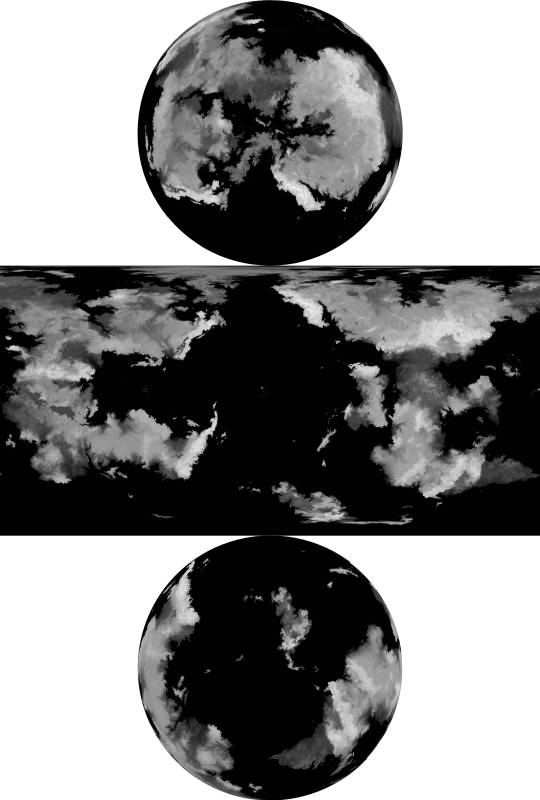
Here is the same elevation data, presented without the color gradient.
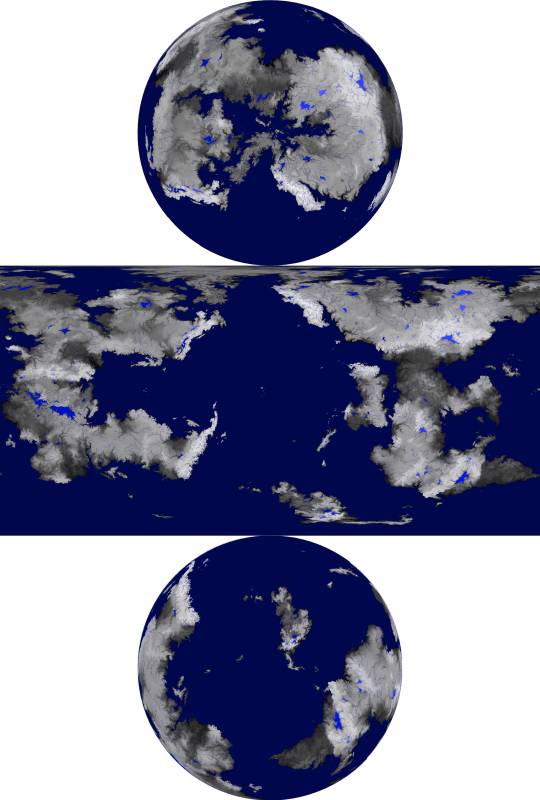
This time, the elevation is presented with bodies of liquid water included, such as rivers, oceans, and lakes.

and in this one, the water is isolated from the other data, against a white background

Next, there are the surface temperatures that occur on this planet, the key to which is shown above. The four maps below show the seasonal temperatures for land and sea, in order of Northern Spring Equinox, Northern Summer Solstice, Northern Autumn Equinox, and Northern Winter Solstice.

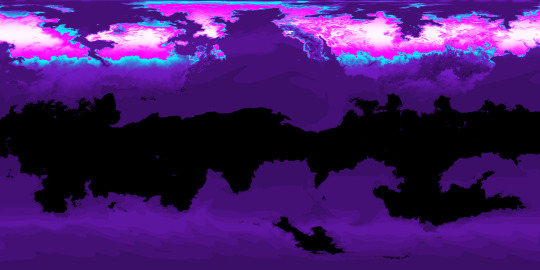
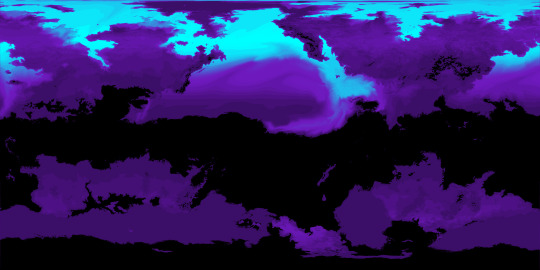

Correlating closely to the above data is the snow and ice cover, which is fairly extensive on this planet owing to its high obliquity and distance from its star. Land ice only occurs where the snow falls and is compacted year-round, but snow and sea ice can be much more seasonal.
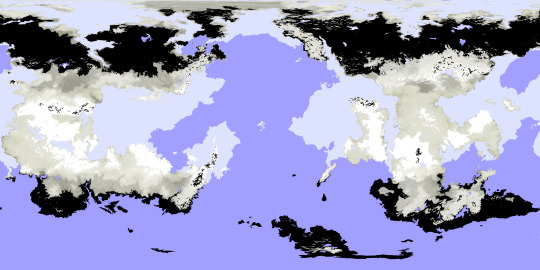
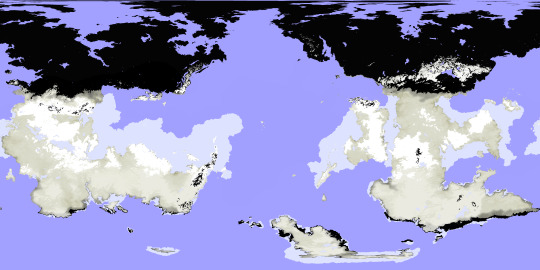
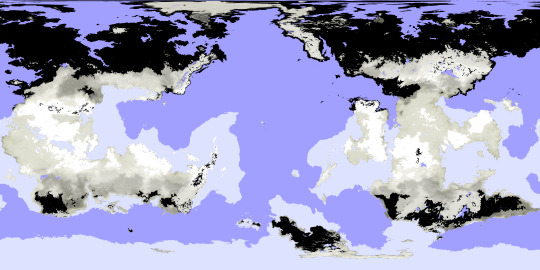
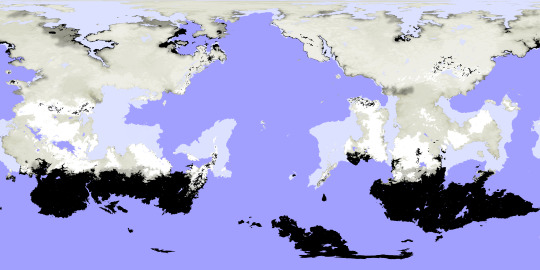
Seasonal precipitation levels were another important phase of this project, and the below diagram shows those levels for a given latitude (y-axis) on a given date (x-axis), with a key attached.
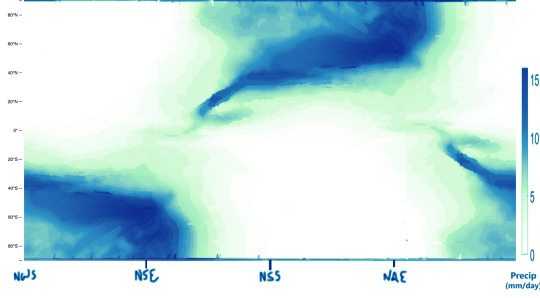
My reference for creating the above graphic is the figure below, which comes from a 2019 paper by A.H. Lobo and S. Bordoni titled “Atmospheric Dynamics of High Obliquity Planets”, and shows Earth’s precipitation levels compared to those of a planet with an 85° obliquity.

The following maps can now be better understood in light of these diagrams and keys.
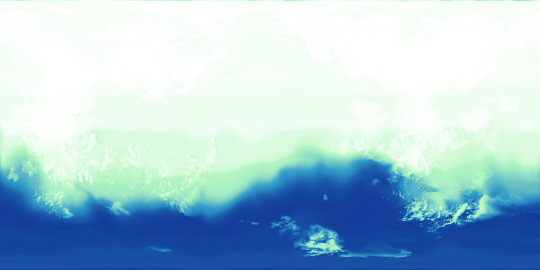
-Northern Spring Equinox
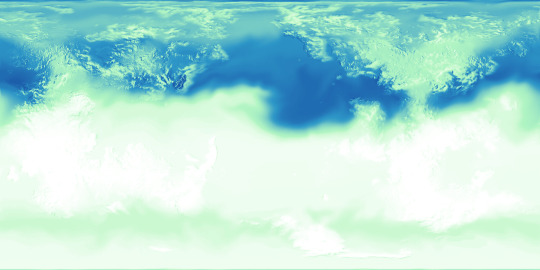
-Northern Summer Solstice

-Northern Autumn Equinox

-Northern Winter Solstice
I was also tasked with mapping out the extent and density of this planet’s vegetation (or at least its alien equivalent), and from this you can see how wildly it varies by season, with very few year-round holdings. Precipitation is a major factor in where it is possible for plants to flourish, but snow cover and the extreme temperature swings limit it too. Near either pole, for example, within the space of a year temperatures soar far above Earth’s upper limits and also plummet below freezing; if either extreme were to be the annual norm for a region, some plants might adapt to those conditions, but because of the wild fluctuation any adaptations to one extreme would leave plants especially vulnerable to the other. These regions, then, remain barren regardless of rainfall or brief windows of mild temperatures, while areas with less wide temperature ranges allow for at least brief periods of flourishing.

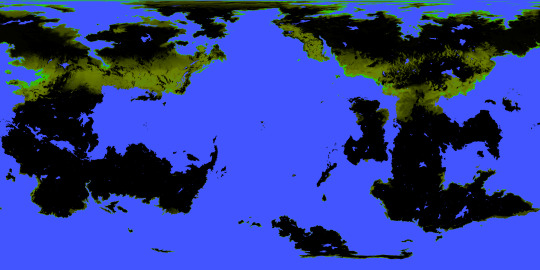
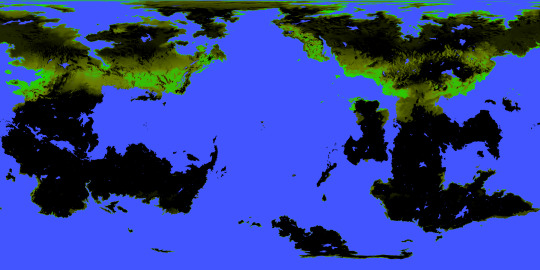
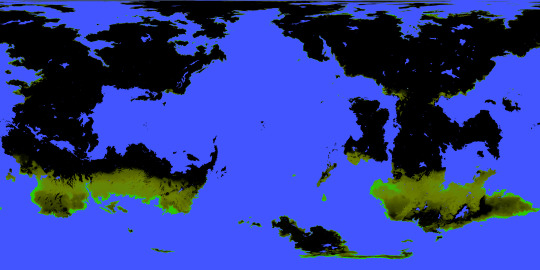
Determining the surface temperatures for this planet required a lot of background work. The first piece of the puzzle for this was knowing the number of daily hours of sunlight for a given latitude and date, which is exemplified first in this diagram for Earth:

and then for the Birdbug planet, below. Since this planet rotates on an axis of 60 degrees, there are many more latitudes within range of either pole that experience periods of sunlight and darkness lasting longer than a day. The higher the latitude, the longer this period lasts, with the poles themselves experiencing either condition for half a year at a time.
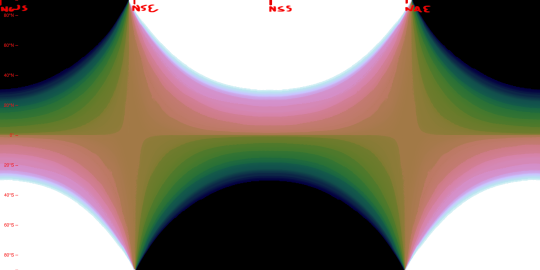
Another important factor is the height to which the sun is seen to rise (more scientifically, the angle at which the sun’s light hits parts of the planet’s surface), seen here first for Earth and then for the Birdbug planet. In these diagrams, white represents the sun reaching the zenith of the sky (meeting the surface at a 90° angle), and black represents the sun failing to appear above the horizon (meeting at an angle of 0° or below), while shades of green and purple stand in for angles between those extremes. For Earth and the Birdbug planet alike, the sun reaches the zenith within the bounds of either planet’s Tropic circles of latitude, and fails to rise at all only within the Polar circles of latitude; the difference in obliquity means that the Birdbug planet’s key circles of latitude are flipped compared to Earth’s.
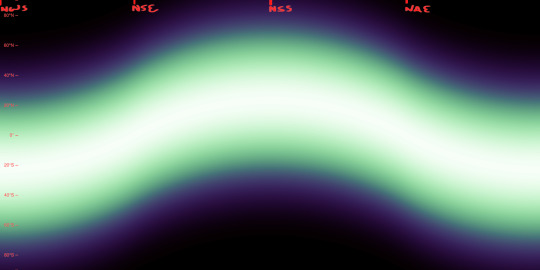
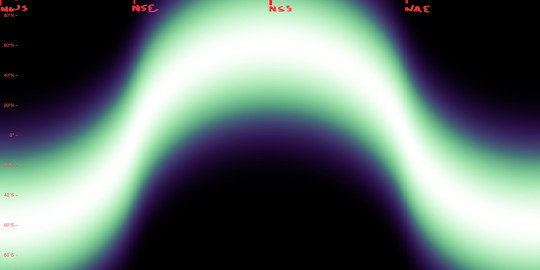
The duration of sunlight and the angle at which that sunlight is reaches the planet’s surface determine a planet’s Insolation, that is, the amount of solar energy it receives. The first image below is a preexisting diagram of Earth’s Insolation, where it is measured in watts per square meter. The next two images are my own attempts at replicating this data for Earth, and then for the Birdbug planet.

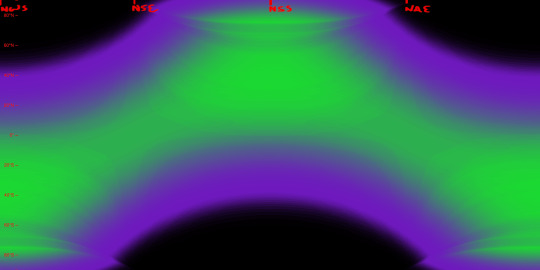
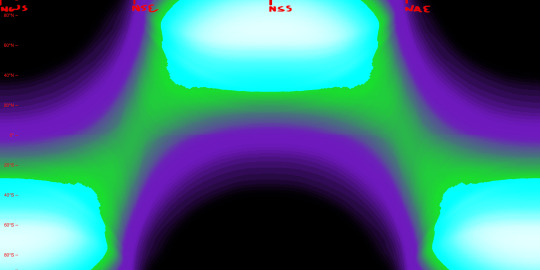
As seen in the diagrams above, Insolation on the Birdbug planet differs from Earth not only in its latitudinal distribution, but also in its sheer intensity at the higher latitudes. Compared to Earth there are twice as many latitudes for which the sun is shining longer than one rotational period, and many of those latitudes see the sun shine at a direct or nearly direct angle, whereas the Polar circles of latitude on Earth see the sun shine much more obliquely.
Below, we can see the data that all the above figures were instrumental in finding: that is, surface temperatures. The first image is a preexisting figure that measures Earth’s mean surface temperatures by date and latitude, and below that is my attempt at replicating the data by my own process.
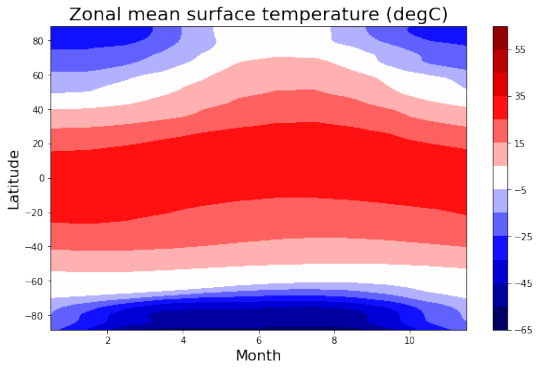
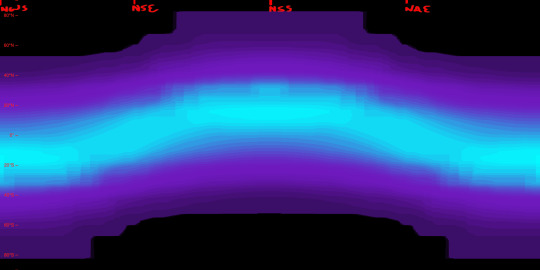
This is done not by just copying the seasonal Insolation data, but by also factoring in the yearly average for each latitude.
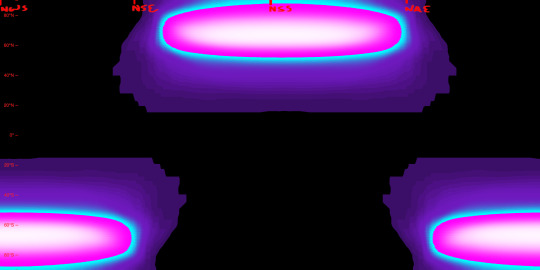
Above, we see the temperatures of the land by date and latitude, and below, we see the temperatures at the surface of the sea, which lag behind the land temperatures and remain comparatively mild.

Lastly, here’s an image I created to combine the snow and ice cover as well as the vegetation extent and density, as of the Northern Spring Equinox. This, along with the elevation map also seen here, is what I uploaded to maptoglobe.com in order to produce the screenshot at the top of this post.
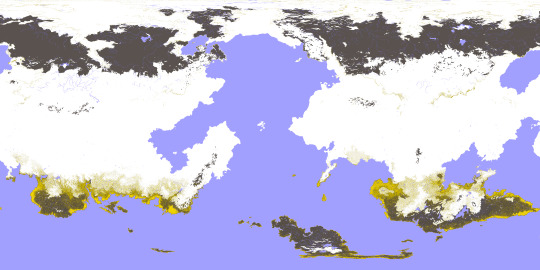
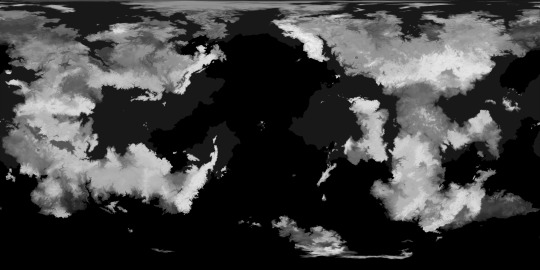
These maps and figures (except for the preexisting ones) were all created in Photopea. Higher resolution versions of many of these images can be seen in my dedicated Reddit posts, linked below:
reddit post one, reddit post two
2022
#mapmaking#imaginary maps#worldbuilding#major project#imaginary planetology#elevation#waterways#river systems#surface temperatures#ice and snow cover#sea ice#precipitation#vegetation#Insolation#high obliquity planets#explanatory diagrams#digital rendering#Photopea#Birdbug worldbuilding project#Birgs#Birgworld#2022#digital painting#extremely long post#Christopher Maida Artwork
616 notes
·
View notes
Text
OK, here's that write-up for catgirl humans I said I'd do, though in developing them I've moved away from the catgirl concept and toward imagining a species that might be less misleadingly called "bearfolk," so I think I'll just call them bearfolk from now on (at least until I decide on what they'd call themselves).
Bearfolk are a species for my sci fi setting. In the setting, they're one of maybe seven or ten sapient species descended from proto-humans transplanted to other planets by aliens in the Pleistocene for reasons I haven't decided on yet (and which may or may not be a mystery to humans in-universe). The ancestors of the bearfolk were transplanted to a world which has a long (tens to hundreds of thousands of years) cycle in which the axis obliquity changes from less than 10 degrees to more than 60 degrees and back again.
As well as the periodic climate changes, the bearfolk world had another environmental difficulty: many of the plants were poisonous or otherwise not nourishing or poorly nourishing to humans, and many of the small animals were poisonous or venomous. That left big animals as the best available food source, and pushed the ancestors of the bearfolk into relying on big game hunting as their primary food source (though it is important to note that the bearfolk never became pure carnivores; when they developed civilization the backbone food production system of their civilization was the same as ours; edible seed and tuber crop cultivation).
The proto-bearfolk at this stage were not very technologically sophisticated, and probably not yet fully sapient. Their primary big game hunting technique was to attack animals with stabbing spears. Unfortunately, this was quite dangerous against larger fauna, so the early proto-bearfolk suffered a high young adult mortality rate. This created a selection pressure for increased size, increased strength, increased resilience against injury, and increased intelligence. The biggest, strongest, toughest, smartest proto-bearfolk were more likely to survive their hunts long enough to reproduce, so over time the species started to get bigger, stronger, tougher, and smarter.
The proto-bearfolk got a stroke of genetic bad luck. Some of the changes that increased their intelligence mildly degraded their fine motor coordination (maybe the evolution of their sapience involved the cerebellum shrinking to make room for an expanded neocortex?). The effects were not very debilitating, and in the short term getting a little clumsier but smarter was a net-positive trade-off for survival, so these genes propagated and increased in frequency. But in the long term this had the effect of making them poor shots, which delayed the development of projectile weaponry. It didn't help that a lot of their prey were protected by natural armor, requiring relatively precise targeting of weak spots to take them down; this was much easier from close range. It also didn't help that limited ability to eat from the base of the food chain limited the proto-bearfolk population, and the very adaptations that made them better megafauna-killers (increased size, muscle mass, and brain power) also increased their caloric needs and further limited their population; this tended to make technological progress quite slow even given full human-level intelligence. As a result of these factors, the bearfolk remained locked into taking down prey in close combat with stabbing spears, and exposed to the selection pressures that generated, for a long time.
As their size, brute strength, resilience against injury, and intelligence all increased, fewer of the proto-bearfolk died on the hunt and they were able to tackle bigger and more dangerous prey, as well as more effectively compete against rival predators. Eventually they became one of their planet's apex predators, regularly taking down megafauna much bigger than themselves. The end result of this process was a sapient species significantly bigger and much heavier and stronger than Homo sapiens.
The other important selection pressure bearfolk got that we didn't is their ancestors experienced at least one of their planet's high obliquity eras. During these eras much of the planet experienced more than a month of continuous darkness in winter. This created a selection pressure for ability to operate in darkness, specifically for improved night vision, improved senses of hearing and smell, and increased reliance on senses other than vision.
So, modern bearfolk...
They have much better night vision than Homo sapiens, better hearing, and a better sense of smell. They tend to rely more on senses other than vision. One noticeable external anatomical difference is their earlobes are bigger and more conical than ours and have some mobility, to capture sounds better; they're not exactly cat ears, but they might look a little like that.
They're pretty big, and have much more muscle mass than Homo sapiens. I haven't decided exactly how big. My "not all that different from us" model is they're not all that much taller than us (average height six-foot-something), but much more heavily built, with much more muscle mass. If you want to imagine what a bearfolk looks like, a strongman like Hafthor Julius Bjornsson is a good place to start. Note that this is my "well, let's assume they're small enough their furniture wouldn't be too awkward for us and vice versa so shared social events and work-spaces would be relatively easy" model; I might make them bigger. As you might extrapolate from this description, they're very strong. Put the bearfolk equivalent of a moderately in-shape yoga mom in the Olympics and she might win a gold medal or ten.
They've retained more "primitive" hominid features inherited from the common ancestor; they have Neaderthal-like "chinless" jaws, heavier brow ridges than us, and a more robust skull. They're a bit like Neanderthals in combining these "primitive" features with a brain that's, if anything, bigger than ours. I think this would fit with them having evolved toward even more robustness instead of gracility. One exception to this is bearfolk males have lost male-pattern facial hair; this might be because it was easier to clean blood and other animal fluids off a hairless face, or it might be just a result of genetic drift.
Increased sharpness of the incisors and canines fits my mental image of them, but realistically I don't think it's plausible: knives and controlled fire are some of the oldest human technologies, and once you have them there isn't much selection pressure for tooth anatomy changes. Maybe it's a side effect of selection for some other trait, like the long hairs on the legs of big horses?
Despite their prehistoric specialization as mostly-carnivores, they never lost the human capacity to eat a wide variety of foods. Nowadays they eat more seed and tuber crop derived foods than meat, for the same reason we do.
A quick skim of a Wikipedia article says Hafthor Bjornsson took 8-10,000 calories a day to maintain his peak strongman physique, which would suggest if bearfolk have a similar physique they'd need to eat a lot. Then again, I'd guess an Earth human has to work out a lot to maintain that kind of muscle mass, whereas bearfolk would more-or-less just have it by default, so that might help. Even so, I'm pretty sure all that extra muscle would take a lot of extra calories and protein to maintain.
Ideas about bearfolk society and stuff:
Bearfolk population densities were pretty low in their ancestral environment; limited ability to eat from the base of the food chain and high individual caloric needs limited their population. Compared to Homo sapiens with equivalent technology and in similar environment, their social groups were smaller and more dispersed. On the one hand, this meant less selection for hypersociality. On the other hand, dangerous cooperative hunting selected for strong bonds within the group (nearest available Earth analogies: war buddies).
Translate this into modern times... On one hand, they tend to be less comfortable and more stressed when dealing with crowds and social interactions with people they don't know well. On the other hand, they tend to have strong bonds with romantic partners and close friends (the two are heavily overlapping categories in their society). They tend to have little taste for socializing in dance halls and big parties and the like, preferring small intimate gatherings with friends. Accordingly, their shared social spaces tend to be more set up to facilitate the latter kind of socialization. I think they might seem kind of autistic to us.
In terms of social structure, they actually have a lot of similarities with bonobo-like humans. Like bonobo-like humans, they tend to form large co-operative child-care units with lots of alloparenting. Like bonobo-like humans, they often rely on clubs, friend groups, extended family, worker cooperatives, group homes, etc. for cooperative child-care services that in our society would normatively be performed by the nuclear family. Like bonobo-like humans, they tend to live in group homes. In bearfolk this reflects patterns of social organization that were originally adaptations to the high young adult mortality rate of the hunter period (in bonobo-like humans they were partly responses to the higher risk of orphaning resulting from their age-mediated reproduction patterns, so there is some similarity there).
Thinking about sort of situation their society might have regarding gender and sexuality... Regarding gender, I think the short answer would be that bearfolk have a lot less of it than us:
Both sexes were hunters and heavily selected for large size and great strength. Sexual dimorphism is much lower than ours; bearfolk women aren't much smaller than bearfolk men. Native animal, bacterial, fungal, and viral parasites have difficulty infecting them because of how different they are from native animals physiologically, so pre-industrial child mortality was much lower than on Earth - in their hunter period young adult mortality was high, but it would have been greatly reduced by the development of effective projectile weapons, animal domestication, or agriculture (I haven't worked out which of those they got first). Childbirth is less strenuous to them because of how big and robust they are (I guess their babies might be a bit bigger than ours, but the difference is smaller than between sapiens and bearfolk adults). As I said earlier, they tend to form big cooperative child-care units and do lots of alloparenting. All this tended to reduce the degree to which their society treated men and women as different types of being with different rights, responsibilities, and roles.
Bearfolk men and women don't look very different. Bearfolk women have similar physique to bearfolk men, are only slightly smaller, and have small breasts. Bearfolk don't really have gendered clothing, or at least don't have much of it (at minimum, I guess menstrual pad equivalents are a kind of gendered clothing and they'd have those); men and women mostly wear about the same things (they tend to favor practical clothing). Bearfolk don't have the "women as the decorative sex" thing; they sometimes wear fancy clothing and jewelry of various sorts, but this isn't a gendered thing in their society, it's simply an attempt by the individual to look nice and/or advertise their high social status.
Perhaps because it has so little gender, Bearfolk society basically never stigmatized homosexuality.
Regarding sexuality more generally, I like the idea that Bearfolk are simultaneously a more and less sexual species than Homo sapiens, depending on how you look at it.
On one hand, they tend to have low libidos and be basically demisexual. One easily visible manifestation of this you might notice if visiting their planet is they don't do stuff like put suggestive images in advertisements and they don't have "sexy" fashion. I also think they wouldn't make much erotic art, and what they do make along those lines would look kind of weird to us; like, e.g. their movies might have sex scenes when they're character-significant, but I think they'd be shot pretty differently from ours. Casual sex, hook ups, and sex work would be much less prominent institutions in their society, since most of them would usually be uninterested in sex with strangers. Similarly, I think visual porn with minimum story wouldn't really be much of a thing in their society (but they might have more appreciation of romance novel and smutfic type things and have an equivalent literary tradition).
Side note: while they don't have "sexy" fashion and this does tend to result in generally modest clothing (at least in cooler climates), they also don't have much of a nudity taboo, and are quite chill about seeing each other nude in settings like public bathing facilities. These are to some extent two sides of the same coin; it doesn't occur to them that there might be something inappropriate about a bunch of strangers being naked together in a public bath or sauna or on a beach cause to them there is nothing potentially sexually arousing about this situation.
On the other hand, their society is polyamory-normative. They have a similar thing to bonobo-like humans going on where clubs, friend groups, small worker co-ops, etc. are often also polycules. They do tend to form very close, strong, intimate life partnerships with small numbers of people, but, 1) these are usually "open relationships," 2) they are often between three or four or more people instead of just two.
I think in the ancestral environment bearfolk romantic relationships (both homosexual and heterosexual) would have had a kind of Sacred Band of Thebes flavor. Not sure if or how this would influence their present society.
Also a major exception to bearfolk demisexuality is I think in the ancestral environment they'd have had inbreeding-avoidance behaviors like a woman who wanted to get pregnant sometimes waiting until she was nearing ovulation and then going to a neighboring group hers was on OK-to-good terms with and basically getting consensually gang-banged by the adult males of the other group, so that genes would be exchanged. They might have some modern practices distantly derived from such behaviors.
That reminds me, I think having a better sense of smell than us might have led to them getting a functional equivalent of modern birth control very early, similar to what happened with bonobo-like humans; they might be able to smell physiological changes associated with ovulation.
On a sad note, I think a high young adult mortality rate in the ancestral environment might lead to them getting less selection pressure for long lifespan, and hence being less long-lived today? They might have something kind of like the bonobo-like human late menopause relative to lifespan, but whereas bonobo-like humans got it by having really late menopause, bearfolk might have it just cause they kept a more chimp-like life cycle; adult by 15, menopause at 50 which is already elderly for them, usually dead by 70. :( On the other hand, high young adult mortality rate would mean the people who did manage to survive to older age were even more precious as teachers for the next generation of hunters and basically living libraries, so there'd be kin selection pressure for long lifespans that way. Also I could see them developing toward a pattern where reproduction and mothering tends to be done by older females who are past their prime as hunters, so they might get selection pressure for longer lifespan, later menopause, and slower female fertility decline that way (this arrangement would be something a little bit like our gender roles, but age-mediated!).
15 notes
·
View notes
Text
Vorkosigan Saga Readalikes
I was going to wait to write this until I had three options, but I haven't yet thought of a third series that really gives me those Vorkosigan Vibes, and I don't want to sit on these any longer. Both the Earth Girl series and the Merchant Princes series remind me of the Vorkosigan Saga in various ways.
It's some combo of similar themes, characters, setting, multiple installments, and compulsive readability. Like with the Vorkosigan saga, I eventually lost the ability to wait for friends/the library to deliver the sequels to me, and I ended up buying later installments/the whole series on my ereader so I could have them on-demand.
Vorkosigan Saga…but YA
The Earth Girl series by Janet Edwards
2788. Only the handicapped live on Earth. Eighteen-year-old Jarra is among the one in a thousand people born with an immune system that cannot survive on other planets. Sent to Earth at birth to save her life, she has been abandoned by her parents. She can’t travel to other worlds, but she can watch their vids, and she knows all the jokes they make.
Jarra is a historian-in-training with a lot of experience excavating ruins on Earth, who joins a class of newbie offworld students under false pretenses, basically to show them up and get proxy revenge on the galactic society that's made her a second-class citizen. Then the false military background she concocts for herself- and the relationships she makes with her classmates- turn out to be more real than she ever intended.
Like Miles, Jarra is desperate to prove herself and does all sorts of stupidly heroic nonsense. Her disability is maybe even more of a cultural construct than Miles's is, while still having enormous influence on her psyche, childhood and career goals. The military in this series, which Jarra hero-worships, is (now) strictly a space exploration/terraforming force.
Hilariously, this series also has a Beta (sector) with a cultural tradition of looser sexual mores/trio marriages. There's also a sort of 'second career' arc for Jarra that's very satisfying, after you get lots and lots of fun and suspenseful archeological excavations (I'm not being sarcastic, they're fascinating!) The secondary cast is also really interesting, and there are installments in the series that explore their backstories and post-Jarra paths.
I read this as an adult (it was a tumblr rec!) and thoroughly enjoyed it, so I would absolutely recommend it to adult Vorkosigan Saga fans. It is firmly in the YA bucket in terms of being a coming-of-age story, so you could also gift it to somebody who might be too young for the Vorkosigan Saga and its' bucket-o-content-warnings, but who you otherwise think would love Miles. (This is not really a Vorkosigan similarity, but I also want to give the series a shoutout for realistic-seeming teen slang, which is harder to do well than you'd think.)
Vorkosigan Saga…with extra Cordelia please
The Merchant Princes series by Charles Stross
By the time we meet them at the dawn of the 21st century the Clan of five families who by careful arrangement can produce offspring who world-walk [to parallel universes] have become, in their home world, richer than Croesus. But all this wealth comes at a cost, and envious eyes are watching them just as a business journalist in Boston loses her job and discovers a family heirloom that topples her straight into a cliché that can only end badly in real life: the orphan who discovers she’s the long lost daughter of a noble house, and the subject of all their expectations.
Miriam Beckstein reminds me of Cordelia- a high-tech, driven woman who suddenly finds herself enmeshed with a group of literally feudal relations and embroiled in their political/personal schemes. Like Cordelia, she also sets out on a modernization process for her adopted culture(s), although she has less oblique strategies at her disposal than Cordelia does.
There is also a thematic focus on genetics in this series, and some of the power dynamics connected to that are explored in even greater detail than in the Vorkosigan Saga. The world-walkers have a complex arrangement of arranged marriages to keep the genetic ability to teleport to other timelines, and so like on Barrayar (and Cetaganda), the grandmothers who arrange these marriages are the ones really running the genetic show. (There's also a similar plot thread of 'culturally traumatic nuclear bombings'.)
My favorite part of this series is the latter half, when Miriam meets a political dissident in yet another alternate timeline and works with him to transform his world, and hers in the bargain. If you wanted to see Cordelia winning on a faster timeline, you'll love Miriam and her 30-year plan. There's also a sequel series that explores another member of the family, which has a lot of spy thriller elements and a lesbian romance. (Not going to say too much there, because spoilers.)
My spouse says this series is too 'of its time' for him to really enjoy it, by which he means that the ultimate villain is Evil Mastermind Dick Cheney. This doesn't bother me, but I mention this in case you, too, think Evil Mastermind Dick Cheney is a somewhat dated plot element from the vantage point of 2023. It's definitely more of a Cordelia-and-Aral readalike than a Miles readalike, although the sequel series has some superficial similarities to the introduction of Mark, now that I think about it!
I hope this gives you some new books to check out, all 10 of you Vorkosigan fans that might see this.
#vorkosigan saga#the vorkosigan saga#earth girl#the earth girl series#earth girl series#merchant princes#the merchant princes
35 notes
·
View notes
Text
Mapping a world other than Earth
So a while back I made this world map for a worldbuilding project that never really went anywhere beyond this.
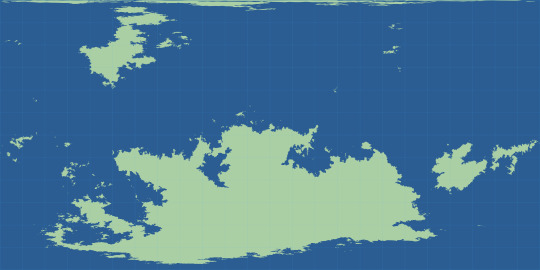
I wanted to find a good projection for this map, so I originally made it in equirectangular, because G.Projector takes it as input and the distortions are relatively easy to work out compared to other projections (Everything is the right height, and just gets wider near the poles, the main hard thing was having to make a polar island basically blind to what it was going to end up like.)
If you want to see the actual continent shapes the easiest way is probably the orthographic projection (What things would look like from space, but if you were technically infinitely far away, i.e. the projection lines are parallel), the south hemisphere is a video to get the entire thing in.:

A new layout of continent shapes gives some really interesting opportunities for which projections work well and which don't because you lose some of the familiarity for distortions with a map of Earth, for example I dislike equatorial aspect cylindrical and pseudocylindrical projections on this map because it feels like it distorts the poles in a way that seems wrong to me. Like we're all used to seeing Antarctica big but I don't really want to see that small island stretched across the north pole line.
This is going to be quite long so I'll put a cut here.
Projections that don't really work
In general I don't think flat-pole pseudocylindrical projections that are common for world maps of Earth really work for this planet. Here's the Robinson (A very common projection) and the Kavrayskiy VII (My personal favourite general-purpose projection):

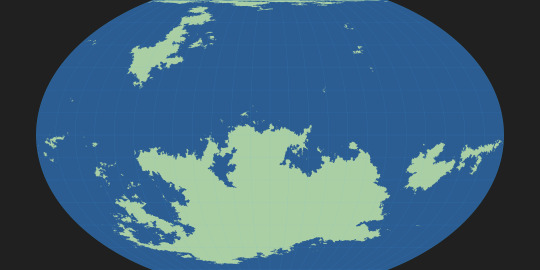
I think the problem is mainly because there's more coastline outside of 75°N/S here. Antarctica is big so most of it's coastline is relatively far from the pole, and most of the coast of Russia and Canada is further from the pole than the coast of the southern continent here.
For reference here's the Mercator projection cropped to 85°N/S like most of the ones of Earth are:

Like while the Mercator makes Antarctica very big with Earth, it doesn't actually cut off any coastline. In general I just think common map projections for Earth distort the northern continent or the southernmost peninsula on the left of the southern continent.
If you really need a projection centred on the equator, you can sort of get away with the point-pole projections that have "lobes", like the Van der Grinten IV, additionally you can shift the centre to 34.2°W without cutting through any land, which I think reduces angular distortion of the problematic bits somewhat, though results in an asymmetrical graticule.

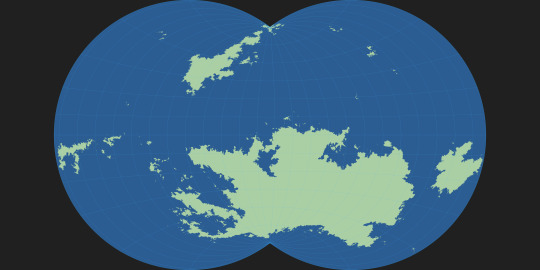
At the time I originally made it, my favourite way of presenting it was an Equirectangular projection, centred on 45°S. This keeps the land away from the high distortion areas, there's basically no land within 25° of the "poles" of this map, and if you really want to have no land being interrupted you can offset it horizontally like the second image to put the north polar island back together.


Recently I've found a bunch of other projections that look good for it, most of them oblique. Originally I was only using G.Projector which is great but only has a few projections that allow for oblique aspects, but recently I've discovered Map Designer Raster which is much freer in that regard, so I realised that this aspect looks pretty good with the Mercator projection (cropped to the golden ratio):

For comparison here's a Cylindrical Equal-Area version (standard parallels at 30°), they're mostly pretty similar except for the bits closest to the top and bottom:

In general these two are probably both more useful than the Equirectangular what with one being conformal and the other being equal-area, though aesthetically the equirectangular is a good compromise.
I also wanted to make one that showed the northern continent well and realised that despite cutting the southern continent in half an equatorial aspect of the Stereographic projection works pretty well. The centre of that continent would probably be relatively sparsely populated (most of it would probably be pretty dry, so cold or hot desert depending on latitude):

(Of course if you want to only display the northern continent, a polar azimuthal projection would work fine.)
There's another Stereographic aspect that I've found works really well to show the whole globe without interrupting any land (centred on 15°E 30°S):

This is personally my favourite projection for this planet.
There are a couple of other things you can do with this aspect, you can rotate the hemispheres by 45°, or can also use the same aspect for the oblique cylindrical projections, which results in something like this for equirectangular, though personally for the cylindrical projections I think the 45°S aspect from earlier works better:


I actually worked out how to get this aspect working with the Peirce Quincuncial / Adams Hemisphere-in-a-Square projection, and it's probably a personal choice whether you prefer this to the Stereographic. They're both conformal it's just where you want the area distortion, the Stereographic spreads it out around the circle, while the Peirce has higher distortion confined to a smaller area (close to the corners).

I think I'm definitely a big fan of conformal projections for world maps, it seems more worth it to use a conformal projection with low area distortion than a true equal-area projection.
I think if I ever did a real world map with more detail and stuff, I'd probably go with something like the stereographic one that cuts the southern continent in half, it's the one that I could realistically see getting widely used in-universe, at least pre digital.
48 notes
·
View notes
Text


How Pluto got its heart
The mystery of how Pluto got a giant heart-shaped feature on its surface has finally been solved by an international team of astrophysicists led by the University of Bern and members of the National Center of Competence in Research (NCCR) PlanetS. The team is the first to successfully reproduce the unusual shape with numerical simulations, attributing it to a giant and slow oblique-angle impact.
Ever since the cameras of NASA's New Horizons mission discovered a large heart-shaped structure on the surface of the dwarf planet Pluto in 2015, this "heart" has puzzled scientists because of its unique shape, geological composition, and elevation. A team of scientists from the University of Bern, including several members of the NCCR PlanetS, and the University of Arizona in Tucson have used numerical simulations to investigate the origins of Sputnik Planitia, the western teardrop-shaped part of Pluto's "heart" surface feature. According to their research, Pluto's early history was marked by a cataclysmic event that formed Sputnik Planitia: a collision with a planetary body about 700 km in diameter, roughly twice the size of Switzerland from east to west. The team’s findings, which were recently published in Nature Astronomy, also suggest that the inner structure of Pluto is different from what was previously assumed, indicating that there is no subsurface ocean.
A divided heart
The "heart", also known as the Tombaugh Regio, captured the public's attention immediately upon its discovery. But it also immediately caught the interest of scientists because it is covered in a high-albedo material that reflects more light than its surroundings, creating its whiter color. However, the "heart" is not composed of a single element. Sputnik Planitia (the western part) covers an area of 1200 by 2000 kilometers, which is equivalent to a quarter of Europe or the United States. What is striking, however, is that this region is three to four kilometers lower in elevation than most of Pluto's surface. "The bright appearance of Sputnik Planitia is due to it being predominantly filled with white nitrogen ice that moves and convects to constantly smooth out the surface. This nitrogen most likely accumulated quickly after the impact due to the lower altitude," explains Dr. Harry Ballantyne from the University of Bern, lead author of the study. The eastern part of the "heart" is also covered by a similar but much thinner layer of nitrogen ice, the origin of which is still unclear to scientists, but is probably related to Sputnik Planitia.
An oblique impact
"The elongated shape of Sputnik Planitia strongly suggests that the impact was not a direct head-on collision but rather an oblique one," points out Dr. Martin Jutzi of the University of Bern, who initiated the study. So the team, like several others around the world, used their Smoothed Particle Hydrodynamics (SPH) simulation software to digitally recreate such impacts, varying both the composition of Pluto and its impactor, as well as the velocity and angle of the impactor. These simulations confirmed the scientists' suspicions about the oblique angle of impact and determined the composition of the impactor.
"Pluto's core is so cold that the rocks remained very hard and did not melt despite the heat of the impact, and thanks to the angle of impact and the low velocity, the core of the impactor did not sink into Pluto's core, but remained intact as a splat on it," explains Harry Ballantyne. "Somewhere beneath Sputnik is the remnant core of another massive body, that Pluto never quite digested," adds co-author Erik Asphaug from the University of Arizona. This core strength and relatively low velocity were key to the success of these simulations: lower strength would result in a very symmetrical leftover surface feature that does not look like the teardrop shape observed by New Horizons. "We are used to thinking of planetary collisions as incredibly intense events where you can ignore the details except for things like energy, momentum and density. But in the distant Solar System, velocities are so much slower, and solid ice is strong, so you have to be much more precise in your calculations. That's where the fun starts," says Erik Asphaug. The two teams have a long record of collaborations together, exploring since 2011 already the idea of planetary "splats" to explain, for instance, features on the far side of the Moon. After our moon and Pluto, the University of Bern team plans to explore similar scenarios for other outer Solar System bodies such as the Pluto-like dwarf planet Haumea.
No subsurface ocean on Pluto
The current study sheds new light on Pluto's internal structure as well. In fact, a giant impact like the one simulated is much more likely to have occurred very early in Pluto's history. However, this poses a problem: a giant depression like Sputnik Planitia is expected to slowly move towards the pole of the dwarf planet over time due to the laws of physics, since it has a mass deficit. Yet it is paradoxically near the equator. The previous theorized explanation was that Pluto, like several other planetary bodies in the outer Solar System, has a subsurface liquid water ocean. According to this previous explanation, Pluto's icy crust would be thinner in the Sputnik Planitia region, causing the ocean to bulge there, and since liquid water is denser than ice, you would end up with a mass surplus that induces migration toward the equator.
However, the new study offers an alternative perspective. "In our simulations, all of Pluto's primordial mantle is excavated by the impact, and as the impactor's core material splats onto Pluto's core, it creates a local mass excess that can explain the migration toward the equator without a subsurface ocean, or at most a very thin one," explains Martin Jutzi. Dr. Adeene Denton from the University of Arizona, also co-author of the study, is currently conducting a new research project to estimate the speed of this migration. "This novel and inventine origin for Pluto's heart-shaped feature may lead to a better understanding of Pluto's origin," she concludes.
TOP IMAGE....View of Pluto taken by NASA's New Horizons space probe on July 14, 2015. Credit: NASA/Johns Hopkins University Applied Physics Laboratory/Southwest Research Institute.
LOWER IMAGE....Artistic representation of the huge and slow impact on Pluto that led to the heart-shaped structure on its surface. Credit © University of Bern, Illustration: Thibaut Roger
6 notes
·
View notes
Video
Perspective view of Mars’s Tharsis volcanoes by European Space Agency
Via Flickr:
This oblique perspective view shows a slice of Mars imaged to mark a milestone for ESA’s Mars Express: its 25 000th orbit around the Red Planet. It was generated from a digital terrain model and the nadir (downward-pointing) and colour channels of Mars Express’s High Resolution Stereo Camera. The vertical scale is exaggerated by a factor of approximately three, making the volcanoes look three times higher than they are in real life. Three of Mars’s famously colossal volcanoes are shown here: from left to right, Arsia, Pavonis and Ascraeus Mons. The mound of Mars’s largest volcano, Olympus Mons, can be spied further away at the top of the frame, while the fractured terrain of Noctis Labyrinthus, Mars’s ‘labyrinth of night’, can be seen in the foreground. Read more [Image description: This image shows a tan-coloured portion of Mars, with the curvature of the planet visible to the top left the frame. Four of Mars’s volcanoes can be seen in relief against the dark background, shown as darker mounds stretching away from the viewer.] Credits: ESA/DLR/FU Berlin, CC BY-SA 3.0 IGO
#ESA#European Space Agency#Space#Universe#Cosmos#Space Science#Science#Space Technology#Tech#Technology#Mars#Dunes#Panorama#Marte#Solar System#Sol#Mars Express#HRSC#High Resolution Stereo Camera#DLR#Red Planet#Exploration#Phobos#Volcano#Arsia Mons#Pavonis Mons#Ascraeus Mons#Olympus Mons#Noctis Labyrinthus#flickr
3 notes
·
View notes
Text

Best Greetings
Five Wrong Theories In The Sun Formation and Nature (1)
1st Wrong Theory / The Sun Rays Creation
The Physics Book tells (The Sun Is Doing Nuclear Fusion To Produce Its Rays)
WRONG
The Sun Is Not Doing Nuclear Fusion To Produce Its Rays – instead -
The Sun Rays Is Created By The Planets Motions Energies Total –
The sun is a phenomenon created by the planets motions – the sun is created after all planets creation and motion – the sun is a phenomenon and its life and death depends on a cycle-means- after this sun death another sun will be created for the solar system
DETAILS
Any moving body produces energy (1/2 mv^2), but where's Planet Motion Energy? The planet can't store its motion energy in its body otherwise it would raise this planet temperature- logically- the planet motion energy must be stored in the space in waves form.
The space is similar to the sea of water- the planet motion energy creates waves in the space (as the fish motion creates waves in the sea)- The planet motion energy is stored in these waves – the space waves are typical to the sea waves – these waves move far from its source and can be reflected.
The scientists discovered these space waves and they called them (the gravitational waves) supposing these waves are produced by the gravitational field – but- in fact- these waves are produced by the planets motions energies
Understandable the motions energies can NOT be accumulated in the space forever- BUT where No use of any energy is discovered in the solar system except The Sun Rays- that tells the sun rays is created from this stored motion energy
PROVES
(No.1)
(The new article) This Is Extraordinary: Gravity Can Create Light, All on Its Own
https://www.msn.com/en-us/news/technology/this-is-extraordinary-gravity-can-create-light-all-on-its-own/ar-AA19YL5d?ocid=hpmsnHYPERLINK "https://www.msn.com/en-us/news/technology/this-is-extraordinary-gravity-can-create-light-all-on-its-own/ar-AA19YL5d?ocid=hpmsn&cvid=620db4352aa943e2b454919a7b724604&ei=83"&HYPERLINK "https://www.msn.com/en-us/news/technology/this-is-extraordinary-gravity-can-create-light-all-on-its-own/ar-AA19YL5d?ocid=hpmsn&cvid=620db4352aa943e2b454919a7b724604&ei=83"cvid=620db4352aa943e2b454919a7b724604HYPERLINK "https://www.msn.com/en-us/news/technology/this-is-extraordinary-gravity-can-create-light-all-on-its-own/ar-AA19YL5d?ocid=hpmsn&cvid=620db4352aa943e2b454919a7b724604&ei=83"&HYPERLINK "https://www.msn.com/en-us/news/technology/this-is-extraordinary-gravity-can-create-light-all-on-its-own/ar-AA19YL5d?ocid=hpmsn&cvid=620db4352aa943e2b454919a7b724604&ei=83"ei=83
The article tells
The gravitational waves can move by high velocity motion and can produce A Light Beam–proves massive motion energy is found in the solar system and this motion energy can produce a light beam
It tells- The light beam is produced by the motion energy and not by nuclear fusion
Means- the sun rays is created by the planets motions energies and not by nuclear fusion
(No.2)
There are relativistic effects found in the planets data– and these relativistic effects prove the existence of the high velocity motion (the article refers to it)
(No.3)
The solar system design analysis proves, the sun is created After all planets creation and motion- because- technically the sun existence prevents to add any new planet to the solar group- means- the current planets are added in the solar group before the Sun creation- that proves the sun is created after all planets creation and motion
(Notice The Sun Existence Also Prevents Any Planet To Change Its Orbit)
(No.4)
After The Sun Creation- Jupiter had defined the sun position in the sky relative to the solar planets positions –Jupiter data analysis proves this fact.
(No.5)
Because The Sun Rays Is Created From The Planets Motions Energies- For That- The Sun Data Depends On The Planets Data– The sun data analysis proves this fact – let's see some examples
(I)
Mercury orbital inclination =7 degrees and the sun obliquity =7.25 degrees
(II)
(The sun diameter / the moon diameter) = (Earth orbital distance / Earth moon distance)
(III)
4900 million km (Jupiter Orbital Circumference)= The Sun Diameter x The Moon Diameter = Jupiter Circumference x the moon circumference = 12104 km x 406000 km = 12756 km x 384000 km = 6792 km x 363000 km x 2
(12104 km, 12756 km, 6792 km) are the diameters of Venus, the Earth and Mars
The rest distances are the distances between the Earth and moon in perigee, apogee and orbital distance
Notice
The Sun Rays Creation Details Is Discussed In Point No (**)
Thanks – please read
Physics Nobel Prize For Imaginary Ideas!
or
Gerges Francis Tawdrous +201022532292
Peoples' Friendship university of Russia – Moscow
ORCID https://orcid.org/0000-0002-1041-7147
Facebook https://www.facebook.com/gergis.tawadrous
VK https://vk.com/id696655587
Tumblr https://www.tumblr.com/blog/itsgerges
Livejournal https://gerges2022.livejournal.com/profile
box https://app.box.com/s/47fwd0gshir636xt0i3wpso8lvvl8vnv
Academia https://rudn.academia.edu/GergesTawadrous
Publications http://vixra.org/author/gerges_francis_tawdrous
#математика#астрономия#наука#геометрия#космос#электричество#русский tumblr#quantum physics#astronomy#астрофизика#наш физик легенда#физика#астрономи#physics#astrophysics#учеба#ошибки#science#10 класс#mathematics#maths#школа#русская школа#русский тамблер#решение задач#задачи#механика#outer space#geomtry#mathematiques
2 notes
·
View notes
Text
Writing the thing about how the Barsen’thor’s promotions are politically motivated compelled me to also blab about how that played out with my characters. Unsurprisingly, the answer is messily.
During the Desolator Crisis, Grandmaster Satele Shan tried to raise Jedi Masters on the relevant planets to provide backup for the response team, only to discover they couldn’t assist because of another immediate crisis. Even though all the Jedi affiliated by Terrak Morrhage’s plague survived, many of them are still recovering. New emergencies are always occurring. At least the Council and the Supreme Chancellor have a chance to defuse the situation with the Rift Alliance before it goes critical.
The threat to cut all ties with the Republic is surely a bluff; Erigorm would lose too many major clients, Manaan and Saleucami too much trade. The real risk is that the Republic planets might secede to form their own smaller republic with the neutral worlds. It’s hard enough to keep the Republic as it is functioning; two Republics on poor terms will become a nightmare that cannot be awoken from. Though it is unfair to the Republic worlds not threatening to secede to extort concessions from the Supreme Chancellor, the Jedi Council cannot ignore the political realities. Someone needs to take up the task of appeasing the Rift Alliance.
Supreme Chancellor Janarus is keen on Ekkaia Thome with the fancy title of Barsen’thor. Syo Bakarn isn’t sure they are the best Jedi for the job though. Ekkaia is competent and courageous, but they aren’t the best at dealing with people outside the Order. Syo sidesteps the Chancellor by privately asking Ekkaia over distance holocom if they would be interested in taking a mission involving placating some political interests, then asking Tomah Awl when Ekkaia says no.
Ekkaia silently resents that Tomah was promoted to Master ahead of her. She isn’t allowed to resent Tomah though; he didn’t ask to be promoted and she was obliquely offered the high-profile mission before he was. Ekkaia isn’t being discriminated against; Knight San-Esi, Hero of Tython, wasn’t promoted to Master either. It would be wrong of her to pass judgment on the Council. It’s not the Jedi Council’s fault for undermining the rank system for political reasons; it’s Supreme Chancellor Janarus and the Rift Alliance’s fault for being shallow.
Ekkaia is certain they will be promoted in due time. It is better to have things done the proper way, so no one can cast aspersions on your reputation. Ekkaia indicates to the Council that they feel ready for the responsibility of training a Padawan.
For her part, Knight San-Esi, Hero of Tython, views it as a relatively minor instance of the long-term problem of the Republic’s government interfering with the internal policies of the Jedi Order through the High Council. There have been nasty incidents in the past, like the Republic encouraging the High Council to exile Tasiele Shan when she petitioned for permission to marry and raise her daughter. Still, Tasiele’s daughter Satele is the Grandmaster. She wouldn’t let what happened to her mother happen to anyone under her authority, right?
So long as she stays away from the Senate it will just be the Order’s internal political mumbo jumbo affecting San-Esi and her promotion prospects.
Unlike Tomah Awl who was born in the Order and Ekkaia Thome who was given over by their family as a young child, San-Esi formally joined the Jedi Order as an adult in her late twenties. After the Great Galactic War and the sacking of the Coruscant Temple, the Order is still desperately short of Jedi. Stumbling across an already trained already powerful free-range scion of a Padawan who left the Order before the start of the Great Galactic War seemed like a gift from the Force. A lot of San-Esi’s training before Tython was her teachers confirming that she had come to them already possessing the skills of a Knight.
Some members of the Jedi Council, including Satele Shan, believe that San-Esi should be fast-tracked for Mastery. Not only is the Order short on Jedi in general, but even as the Grandmaster she sometimes has difficulties persuading them to listen to her. In cases like Master Tol Braga, it’s because he is also on the Council so she couldn’t overrule him when he continued working on his grand plan to redeem the Sith Emperor when two major crises erupted in Act 1. In cases like Nomen Karr, it’s because he cut communication to “avoid endangering a sensitive mission”. In cases like Nomar Organa, it’s because he was from a powerful family whose support the Order wants to maintain. Some Jedi view “Grandmaster” as a symbolic courtesy title and insist they are following the last order they were given by a different member of the Council.
San-Esi and Satele made a good initial impression on each other. They like each other. It’s a relief for Satele to have another Jedi who is eager to help the Council – not just by doing what she is told but by actively trying to identify problems and suggest solutions. That’s the kind of behaviour she wants to encourage.
Some members of the Jedi Council, including Jaric Kaedan, believe that San-Esi should absolutely not be fast-tracked for Mastery. He thinks it’s a bit suspicious that somebody taught by a half-trained Padawan would have developed the full skills of a Knight. The archives record that San-Esi’s mother’s Master was Vala Xuhor, who betrayed the Jedi in the first year of the Great Galactic War. No, he’s not accusing her of being a Dark Jedi or a Sith infiltrator, but it’s been proven there are infiltrators out there and they don’t know what Knight San-Esi got up to during her years as a rogue sentinel. Please don’t make him have this disagreement in public, Satele, he hates having the ultra-conservatives biased against Jedi who joined the Order as adults agree with him.
Tomah is very uncomfortable when they work out just how political their elevation to Master was. The Jedi’s rank system is not meant to be used this way. They do their best to live up to the rank, but the knowledge they shouldn’t have it – that other Jedi know they shouldn’t have it – adds a new layer of uncertainty to their interactions with other members of the Order.
A year passes. Ekkaia Thome and her Padawan are assigned to join Thomah in the hunt for the Children of the Emperor. Ekkaia is promoted to Master to give her the rank that the Jedi Council feels she will need to be taken seriously by the politicians; she had trouble getting the authorities in Act 1 to take her seriously when explaining that the Jedi Masters were possessed, which hopefully being a Master will help with. It also puts her on an even level with Tomah, which is important as they are meant to be co-leading the mission.
The Jedi Council assumed that Tomah would need extra backup to wrangle the Rift Alliance and battle the Children, but it appears that his neutral position between the worlds within the Alliance has made him a powerful leader within it. The Rift Alliance has gone from being a drain on the Order’s resources to actively supporting Jedi missions.
This is incredibly convenient. The Jedi have allies, but in the case of many of them like House Organa, the Jedi have been giving more support than they have been receiving. However, it will be difficult to direct the resources of the Rift Alliance without offending them if the Jedi Council is giving orders to Master Tomah Awl and just expecting the Rift Alliance to pitch in. If Tomah Awl was on the High Council, though, that would be another matter.
The problem with nominating Tomah for the High Council is that the more orthodox Jedi, including some members of the Council, are disquieted by how deeply influenced he has been by his studies with the Voss Mystics. It didn’t worry the Council before, but before they didn’t have reports on what it was the Voss actually believed.
The compromise is that fiercely orthodox Ekkaia also be offered a seat on the Council. Adding two young Masters wildly clashing philosophies does not result in a more harmoniously functional High Council. It does steadily destroy what remains of Tomah and Ekkaia’s friendship.
Ekkaia’s title of Barsen’thor names her as Warden of the Order. It’s her greatest duty to guard the Jedi from Dark influences – from weakness, from selfishness, from moral compromise. Other Jedi Masters made it clear that she was needed to provide a counter-balance against Tomah and she opposes him at every meeting. He represents outside political interference and dangerous Dark Force-traditions that cannot be permitted to affect the Council’s decision making.
San-Esi, when she and her companions return for their time Missing In Action with the Emperor’s Wrath in tow, is changed. Angry, confrontational, talking about hating and killing the Sith Emperor in a way she never talked about anyone before her capture. It’s concerning.
The Jedi Council is extremely sceptical of Lord Scourge’s claim that the Sith Emperor plans to destroy the entire galaxy, for reasons including but not limited to the fact that none of the members of the Council believe that destroying the galaxy is even possible. Still, his defection is convenient and should be capitalised on. Scourge will only follow San-Esi, so she must be assigned to the mission even if some of the Council would normally not be in favour of sending a Jedi displaying a drastic personality shift into the field. Jaric Kaedan says it’s a bad idea to send a Jedi who might be in danger of falling on a mission which could just be a giant trap, but Satele has faith in San-Esi. San-Esi has triumphed against incredible odds before, persevered under incredible stress before.
PTSD and the Force don’t mix well. That was something San-Esi knew, intellectually, before. PTSD affects your ability to regulate your emotions. The Light-Side comes when you are calm; if you cannot be calm, the Force fails you or the Dark-Side grips you to pull you forward instead. Pain, rage, grief, and fear are all parts of life that cannot be avoided. As a Padawan, she was guided through basic techniques drawing on the Dark-Side so that if she ever fell into using it, she would be more in control, less likely to do something she regretted before she came back to herself.
The knowledge of the Sith Emperor that broke Tol Braga burns in her mind. The nightmares about what she did under his control don’t stop. She cannot forget, cannot set it aside. Everyone is in immediate danger as long as the Emperor survives.
She asks Satele for help. Satele refuses her. She contacts Tomah and Ekkaia to ask if they can use the shielding ritual to permanently free Leeha Narezz. They have another mission, but Kira is at least able to tell them what she knows about the Children. People ask if she is alright. She tells them she’s not.
If she falters the mission will fail. If the mission fails everyone will die. If she can’t be calm her anger will have to do instead.
San-Esi knows that she is sliding down, struggling for control. She knows that what she is doing is dangerous. But what choice does she have? Unless the Jedi Council provides enough support to enable her to step away from combat, she must keep fighting.
San-Esi maintains her self-control – more or less – until she reaches Tol Braga. She reaches out with desperate compassion until she realises he is no longer under the Emperor’s control. That he aided the Emperor’s plan willingly. That in his arrogance he led them on that doomed mission and then abandoned them and Warren is dead.
In that moment, San-Esi hates Tol Braga as much as she does the Emperor. He is dead before she makes any conscious decision to kill him.
Satele has faith in San-Esi but that faith is being shaken. San-Esi is increasingly belligerent in her demands for backup for her mission even though she knows that the war has reignited and Jedi are desperately needed everywhere. Bela Kiwiiks tells her that her old Padawan approached her for advice, afraid that her friend was succumbing to the Dark-Side. She receives word that San-Esi executed Warren Sedoru, even though Satele saw with her over the holocom that she was able to subdue him alive. When she tells Satele that she has killed Tol Braga there is only rage and hatred in her words, no regret.
San-Esi really should be recalled to Tython, but Satele and the Council decide to ignore her fall to send her on one more mission. Their intelligence will not remain fresh much longer. It may be years before they have another opportunity to strike directly at the Sith Emperor. San-Esi insists that she will kill the Emperor, even when Satele reminds her it is not the Jedi way.
Some Jedi doubt the truthfulness of her report that Tol Braga, the Conscience of the Order, willingly did the bidding of the Sith Emperor. She ignores Satele’s warnings that the Order knows she’s letting her anger get the better of her, her warnings that she needs to guard herself more vigorously against the influence of the Dark-Side.
Knight San-Esi has stopped listening, stopped trying, stopped caring. Maybe stopped pretending, though it pains Satele to contemplate it.
If San-Esi doesn’t care about her relationship with Satele or her place in the Order anymore, then Satele needs to take drastic measures to force her to acknowledge the problem. Unless Satele can demonstrate to San-Esi her choices have consequences, she will continue down her Dark path until it destroys her.
She stages a confrontation it will be impossible for San-Esi to brush off. Afterwards, Satele realises too late that there had been plenty of bridge still left to burn.
#Meanwhile in a Galaxy Far Far Away#oc: Ekkaia Thome#oc: San-Esi Ouniera-kue#Satele Shan#oc: Tomah Awl#character death cw
2 notes
·
View notes
Text
Like a Fog Holds the Light - Conner Calhoun - Lump Gallery
Jotted gallery notes (in bold) expanded upon herewith.
Tweaking my world. My nervous system registered immediate impact upon entering Lump Gallery in Raleigh, North Carolina, United States of America, Planet Earth, to see to see Conner Calhoun's exhibition Like a Fog Holds the Light. (Reference is made here to specificity of place, emplacement, displacement, transitional contexts experienced in transit and in transition from one site/state/mode to another as salient harbinger of the show's thematic tendencies.) It was a Saturday. My friend Laura drove us. Upon entry into the gallery space I was tweaked, energized, agitated, drawn in. Yet there was nothing loud about the work. The registered impact was of its own order (not hitting but nevertheless expansively projecting). This would be work that exacted specific requirements in its encounter: somatic awareness, cognitive capacity and clairvoyant potentialities on high alert. First impression - nothing obvious, literal or telegraphed. Rather, the work appeared to be oblique, metaphoric and encoded-verging-on-subliminal. The main gallery space was filled with large, largely dark paintings and a few mysterious sculptural constructs on pedestals. Object No. 1 (Ablaze) was a small bisque ceramic house filled with Slim Jim meat sticks (within a vitrine might I add. What is implied by the purported offering of a meat snack denied to the desirous snacker by a plexi barrier? What are the meat implications? The oral implications? The survival implications? The road trip implications? The gendered, body implications ["Jim"? "Slim"?]? And consider the fire implications, both literal and symbolic, implied by the work's title Ablaze.). Object No. 2 (Flower) was a spray can with an oddball sculptural flower attached to and emerging out of the spray nozzle (this trope of insertion, interconnection, diagrammatic interrelations among ostensibly separate elements would be a thematic aspect iterated throughout the show).
[My perception of the] Outlets & infrastructure of the space - altered. As I began to absorb Calhoun's paintings, they began to absorb me. The Chest in Movement (oil on canvas) is a windswept surrealist scenario in which a cartoonish figure of a person wrought in cold gray tones with yellow ovals for eyes stands before a rounded wood table on which is a large open book and a vase with stylized blackish flowers blown by a harsh wind that sweeps through the composition - the windblown flowers cut across the center of the canvas and extend both in front of and behind the person, whose monotone gray hair and beard flow in the same direction (right to left). The vase is superflat, 2D, while simultaneously signaling dimensionality, shaded right to left from muddy yellow to greenish-yellow to black, which both sets it apart from the rest of the pictorial elements - almost as if it has been grafted onto the scene - and anchors the composition. The person's hand slides under the book but inexplicably / miraculously / mystically also casts a long light gray shadow upon its pages, which are open to reveal the Roman numeral "LXXIV" ("74" [the year of someone's birth?]) and the titular phrase "The Chest in Movement" on one side and mysterious diagrammatic illustrations on the other. And what of "a chest in movement"? The phrase holds the potential for both the erotic and the quotidian (throes of ecstasy or simply a body moving through space). But unlike some artwork titles, there is no punning here, no "ah-ha" moment. Calhoun chooses to sustain the mystery rather than offer overt clues. The imaginary landscape behind the painting's protagonist is snowy and white and extends back toward a range of blue and white snow-covered mountains under a flaming yellow-into-orange sunset. The experience of viewing this and many of Calhoun's other paintings is that of encountering a portal to another dimension. I had the sense of beholding, and at times being transported directly into, an alternate mode of being [which left me simultaneously still being myself while also inhabiting aka holding a wholly other mode of reality]. Thus, as I moved through the gallery space, everything became activated and merged into the world perpetuated by the work. I thus experienced something akin to shock in encountering electrical cords, exposed corners, outlets (the actual gallery infrastructure) - all of which had become imbued with encrypted meanings.
Heart rate up not due to overt erotics [which were there] but to overall sense of intention. My somatic response to this show was providing an onslaught of information. Overwhelmed as I was by the impact of the main gallery space [which included aforementioned erotics (a painting titled Took it too far features a face down person with splayed legs and a fantasized black anus-as-crevasse cracking open as if at the epicenter of an earthquake with a mystical thread opening out into a trumpet-like figuration out of which emits something like an unscrolling musical score)], I transitioned into the adjacent gallery space just to get my bearings. There was more work by Calhoun, of a similar world-bending order. It was at this point that I made a mental note and jotted down that my heart was indeed pounding. There were a few casually placed objects on the floor. These included bisque ceramic vessel forms (Imposters and is that a bong?) and three materially compelling ceramic "cans" spray painted a believable metallic silver. They were a bit outsized and kind of wonky, as if they'd been kicked or a bit crushed - and they conveyed a peculiar banality but nevertheless sustained an aura of mystery and gravitas. I am not entirely sure why or how that sense was achieved given the Oldenburg-like goofiness of the presence of the fat, lolling cans. But I feel as though my sense of the cosmic crashing into the quotidian was not merely idiosyncratic as the title of that work, Star Cluster, suggests a similar understanding by the artist.
Parallel/Alternate Universe. Spliced Realities. It was the painting titled i have felt this before / erofeb siht tlef evah i (a title that cleverly "mirrors" the idea of perceptual inversion and/or deja vu) that triggered these notes. The composition of i have felt this... is roughly divided into one third of the left and two thirds of the right side of this large painting. The color palette of the work is conscribed to blacks, grays, whites and various degrees of saturation of (what reads as) phthalo blue. The pictorial plane is bisected by the black line of a wall's edge in a dark room in which a person holds up a lantern toward the wall, with an expanding vector of light illuminating a circle on the wall. On the other side of the wall in a blue room is an entirely distorted figure facing the wall, instead of a lantern, light emanates out of the figure's gaping maw and meets the light on the other side of the wall. Both scenarios include a ladder, a long hanging light fixture and a bench with a paint can, parallel imagery but not precisely mirrored in terms of placement. Another utterly cryptic aspect is how each figure extends a leg in a manner beyond anything humanly possible, as if the limbs were elastic material projected from the body and twisted such that the sole of each foot with bent supporting toes faces the viewer. We can infer the idea of an artist within their studio. The idea of facing a wall. Of shining light. But from there we are cut loose with our own sensations and understandings. The "parallel universe" and "spliced realities" suggested by my original jotted notes are mirrored by the impossibility of ever fully entering or knowing the hermetic meanings, the world apart, of this work.
Mug paintings x 2. [This note addressed the image of a ceramic mug, which was the focal subject of two outlier paintings in the show ("outlier" due to their relative lack of complexity) - simple object studies. It should be noted, however, that the presence of mugs can be found throughout many of the works in the exhibition, functioning as a form of punctuation, pointing to something domestic or habitual or basic within otherwise other-worldly contexts. The recapitulation of the mug imagery also had the uncanny effect of suggesting a roaming presence within and among the paintings.]
Vectors (matte/shine). I came to think about the works in the show in terms of vectors of meaning. I also noticed subtle painterly differentiations of areas of matte and shine finishes.
Philip Guston / Giorgio Morandi / David Salle / Peter Saul / Henri Matisse These are some of the painters whose work came to mind as I considered Calhoun's painting style. These names should not be construed by the reader as containing or limiting what Calhoun is doing in this work. They are simply top-of-mind jottings relative to momentary spatial perceptual observations that emerged in the encounter with it.





1 note
·
View note
Text
I've been talking about bonobo-like humans, but I want to talk a bit about another, different speculative evolution divergent hominid species in the same setting, this one tentatively inhabiting a planet orbiting the star 40 Eridani A (the bonobo-like human homeworld orbits Tau Ceti).
They're inspired a bit by the carnivore people from All Tomorrows and by wondering if I could use speculative hominid evolution to make a being kind of like a catgirl (lol).
Some ideas I'm considering for this species:
The catgirl humans (bit of a misnomer, their population presumably has a roughly 50/50 male/female split like ours, but oh well) might have a deeper and possibly older evolutionary commitment to big game hunting than Homo sapiens. I don't see them as pure carnivores; there's big advantages to being able to eat a wide variety of foods and adaptability is a major strength of a human-like species, and I think developing civilization would probably be difficult for a pure carnivore species; not being able to eat from the base of the food chain would be a huge hindrance to supporting dense populations. Plant agriculture was probably the backbone food source for most of their densely populated settled societies, just like it was for most of ours. But they might be more carnivory-inclined than Homo sapiens.
One obvious possible way this could happen is a lot of the plants on the planet they were transplanted to might be poisonous or otherwise inedible or not very nourishing to humans, pushing their ancestors to rely heavily on hunting. This might be combined with a lot of the small animals being poisonous or venomous, pushing hominids even more toward reliance on hunting big animals. This might also have been a factor in bonobo-like human evolution, but presumably the situation on the planet of these catgirl people was worse, pushing them to rely heavily on big game instead of just being more careful and pickier about what plants and small animals they ate.
I'm intrigued by the idea that the catgirl humans got modern human equivalent language ability later than the Homo sapiens line did and more of the evolution of their intelligence preceded modern human equivalent linguistic ability. This might have led to them getting even stronger selection pressure for general intelligence and theory of mind than we did, to compensate for less efficient communication. I got this idea from Charles Stross's take on Elves, but I'd take it in a different direction (I'm thinking less "sociopaths" and more "autistics").
The catgirl humans might have a lot more evolutionary history of needing to operate in prolonged darkness than Homo sapiens, leading to better night vision and/or maybe echolocation and more reliance on senses other than sight. Earth humans can learn how to do a kind of echolocation, seems plausible that a pre-sapiens hominid could figure that out too, and if they had to operate in prolonged darkness once the technique was invented natural selection might start to operate on natural aptitude for it.
One way this might work is for their planet to have a slow rotation rate, so the nights are very long. Another possibility is a high axis obliquity, maybe rotating "on its side" like Uranus, leading to prolonged seasonal darkness over much of the surface. But these would imply harsh conditions with extreme heat and cold, which contradicts the vague vibes-based mental images I've so far developed of this world, which are of a planet with a pleasant climate.
A more moderate possibility is the planet is warm and has a high but not super-high axis obliquity (maybe 35 degrees or so) and a big polar continent, and the ancestors of this species spent a long time confined to the polar continent's habitable fringe until something gave them an opportunity to spread out (maybe an ice age created a land bridge to lands farther from the pole and gave an impetus to move equatorward).
Another possibility that intrigues me is that the planet had a high axis obliquity at some point within the last million years or so, but the axis has since shifted (say, from something like 60 degrees to something like 35 degrees), giving it much more Earth-like conditions today. I've seen the possibility of rapid (in geologic terms) dramatic changes in axis obliquity cited as a possible problem with moonless Earth-like planets, so this might be a neat nod at that.
A change in axis obliquity like that would massively re-arrange the climate, so if I go with that option it would imply this is a planet that's still recovering from a major mass extinction (in David Brin's terminology, a "holocaust world"). However:
It might help if the shift in the axis was relatively slow, occurring over at least tens of thousands of years, so species ranges would have time to shift around as the climate changed. It might also help if much of the planet's land was a single landmass with a long north-south axis, like the Americas. It might also help if the maximum obliquity was relatively moderate, maybe 60 degrees or so, so the equatorial region wouldn't get too cold (it'd be the coolest part of a high obliquity world in terms of average temperature) and could be a refugia for species that couldn't tolerate dramatic temperature variations.
It might also help - kind of - if the high obliquity era was also an era of high orbit eccentricity and one hemisphere got its summer when the planet was at perigee while the other got its summer when the planet was at apogee. In the summer at perigee hemisphere, the changing distance from the sun would accentuate seasonal extremes, and conditions would be very harsh. But in the summer at apogee hemisphere, the changing distance from the sun would moderate seasonal extremes, and conditions might stay relatively pleasant, with moderate year-round temperatures near the equator and cold (and dark) winters but mild summers (with midnight sun) near the pole.
And evolution might happen surprisingly fast sometimes, especially in species that reproduce quickly and have short lifespans (e.g. insects and their ecological equivalents). And if these obliquity variations are a recurring cycle, like our ice ages, life might adapt to them, making them less ecologically destructive than they would be if they happened to a planet like Earth.
I think this could be kind of interesting. You might get a world where e.g. tropical jungles consist mostly of plants with vestigial adaptations to dry and cold seasons that are simply rarely or never triggered in present day natural conditions. Similarly, lots of animals living in warm climates might have a vestigial ability to develop a thick winter coat, which is simply rarely or never triggered in present day natural conditions. A world like this might have an ecology that's noticeably denuded and still recovering from a big disruption, but still have lots of life.
If the planet is presently in a period of moderate obliquity but high orbital eccentricity, it might be in a hemisphere-asymmetric ice age, which might be another interesting alien touch. That would probably be bad for life though, as it'd mean the friendlier hemisphere in periods of high obliquity would become the cold hemisphere in periods of low obliquity. Unless the summer at perigee and winter at perigee hemispheres switched at some point, in which case the really hot summers and really cold winters hemisphere in the high obliquity era might be the heavily glaciated hemisphere now.
11 notes
·
View notes
Text
Thursday, January 4, 2023
2024 brings wave of elections with global democracy on the ballot
(Washington Post) More than 60 countries, with some 4 billion people, are set to stage national elections in 2024. That means roughly half the planet could go to the polls in what could be the greatest rolling spectacle of democracy in human history. We might not see this number of elections matched until 2048, when the world’s political landscape could look considerably different. In society after society, illiberal values and politicians who embrace them are gaining ground. Numerous elected governments seem bent on undermining core tenets of the democratic project, from the freedom of the press to the independence of institutions such as the judiciary to the ability of opposition parties to fairly compete against the ruling establishment. According to Freedom House, a Washington think tank that monitors the health of democracies, global freedom declined for the 17th consecutive year in 2023. The organization’s annual report cites a wave of coups that ousted elected leaders in Africa. Separately, the International Institute for Democracy and Electoral Assistance said in its annual report that “across every region of the world, democracy has continued to contract.”
Nibbling at the edges of empire
(Foreign Affairs/The Atlantic) The year 2023 saw the greatest global resurgence of armed conflict since 1945: 2024 will be worse. We are living, if not through a World War, then a world at war, the great post- globalisation jostling to divide up the spoils of what was once America’s unipolar imperium. This will be as epoch-defining a period as the late Forties were for Britain, or 1991 for Russia. Unlike the two World Wars, the rival great powers are not challenging the superpower directly—at least, not yet. Instead, American hegemony is being challenged obliquely, as its rivals nibble at the edges of empire, targeting weaker client states in the confidence that the United States now possesses neither the logistical capacity nor the domestic political stability necessary to impose its order on the world. In the Nineties and 2000s, at the height of its unipolar moment, the United States made almost all the world its client state, writing cheques for their security it now struggles to cash: like bankruptcy, decline comes slowly at first, then all at once.
Only half of Americans believe they can pay off their December credit card bill
(USA Today) Only half (51%) of America’s credit card customers believe they can pay off their December balance in full, according to an industry index, signaling a low ebb in “credit card confidence” as the nation emerges from the holidays. The national credit card balance stands at $1.08 trillion, a record high. The average interest rate has reached 21%, the highest point recorded by the Federal Reserve in nearly three decades of tracking. Some retail cards now charge upwards of 30%. The average card customer holds $6,088 in debt, according to a TransUnion report for the third quarter of 2023, up from $5,474 at the same time in 2022.
Missing Chinese student was victim of ‘cyber kidnapping’ scam, Utah police say
(Washington Post) A 17-year-old Chinese student who went missing in Utah last week has been found unharmed, police said, adding that he appeared to be the victim of an elaborate “cyber kidnapping” scheme, a “disturbing criminal trend” in which scammers put people under duress and convince their families that they are being held for ransom. Kai Zhuang, who was living in Riverdale, was discovered “alive but very cold and scared” inside a tent in remote mountains near Brigham City, Riverdale Police Chief Casey Warren said in a statement Sunday. The teen was probably instructed by those conducting the scam to isolate himself, he said. According to the FBI, while the crime can take on myriad forms, it is “always an extortion scheme” in which families are tricked into believing that a loved one has been abducted and are coerced into paying a ransom, though the person claimed to be missing has not actually been taken. Families are often sent voice recordings and photos by the perpetrators in a bid to convince them that the crime is taking place.
Thousands of doctors in Britain walk off the job in their longest-ever strike
(AP) Thousands of doctors walked off the job in Britain on Wednesday, the start of a six-day strike that was set to be the longest in the history of the state-funded National Health Service. Managers said tens of thousands scheduled appointments and operations will be canceled during the walkout across England and Wales by junior doctors, those in the first years of their careers. The doctors, who form the backbone of hospital and clinic care, plan to stay off the job until 7 a.m. on Tuesday. Senior doctors and other medics have had to be drafted in to cover for emergency services, critical care and maternity services. Britain has endured a year of rolling strikes across the health sector as staff sought pay rises to offset the soaring cost of living.
Cold spell in Finland and Sweden sends temperature below minus 40
(AP) Finland and Sweden recorded their coldest temperatures of the winter Tuesday when thermometers plummeted as low as minus 40 degrees Celsius (minus 40 Fahrenheit) as a cold spell grips the Nordic region. Cold and snow disrupted transportation throughout the region, including in Norway where a major highway in the south was closed due to the weather and ferry lines suspended operations. Swedish train operators said the cold snap caused substantial problems for rail traffic in the Arctic north.
Ukraine trains its sights on Russian border region, seeking to stir up discontent
(AP) The Russian military said Wednesday it shot down 12 Ukrainian missiles over Russia’s southern Belgorod region bordering Ukraine, as Kyiv’s forces seek to embarrass Russian President Vladimir Putin and puncture his argument that life in Russia is going on as normal despite the 22-month war. Belgorod Gov. Vyacheslav Gladkov said the situation in the regional capital, also called Belgorod, “remains tense.” The city came under two rounds of shelling Wednesday morning, Gladkov wrote on Telegram. The Russian side of the border with Ukraine has come under frequent attack in recent days. During the war, Russian border villages have sporadically been targeted by Ukrainian artillery fire, rockets, mortar shells and drones launched from thick forests where they are hard to detect. Belgorod, which has a population of around 340,000 people, is the biggest Russian city close to the Ukrainian border. It can be reached by relatively simple and movable weapons such as multiple rocket launchers.
Iran says at least 103 were killed in blasts at a ceremony honoring slain general
(AP) Two bombs exploded Wednesday at a commemoration for a prominent Iranian general slain in a U.S. drone strike in 2020, Iranian officials said, killing at least 103 people as the Middle East remains on edge over Israel's war on Hamas in the Gaza Strip. No one immediately claimed responsibility for what appeared to be the deadliest militant attack to target Iran since its 1979 Islamic Revolution. At least 211 people were wounded. The blasts minutes apart shook the city of Kerman, about 820 kilometers (510 miles) southeast of the capital, Tehran, and sprayed shrapnel into a screaming crowd fleeing the first explosion. The gathering marked the fourth anniversary of the killing of Gen. Qassem Soleimani, the head of the Revolutionary Guard’s elite Quds Force, in a U.S. drone strike in Iraq. The explosions occurred near his grave site as long lines of people gathered for the event.
Turkey Roots Out the Moles
(BBC) Turkey’s government says it’s detained 34 people who it claims were Israeli spies. Turkish officials said that a total of 57 residences were raided as part of “Operation Mole,” and 12 suspects are still at large. Istanbul claims that the individuals were all working with Israel's Mossad intelligence agency and that they were involved in spying and planning abductions. Turkish Interior Minister Ali Yerlikaya claimed that Mossad was seeking to execute “tactical tasks such as reconnaissance, pursuit, assault, and kidnapping against foreign nationals residing in our country,” but Israel has yet to comment on the arrests. As part of Israel’s war with Hamas, the country has stated that it will target Hamas leaders wherever they are located.
Death Toll Rises to at Least 55 After Powerful Earthquake in Japan
(NYT) At least 55 people were killed in the powerful earthquake that struck western Japan on Monday, the authorities said a day after the disaster, as they continued to comb through the rubble of collapsed and burned buildings. A large fire broke out in Wajima after the quake, which registered 7.6 on the Japanese seismic intensity scale. About 33,000 homes in Ishikawa and neighboring Niigata Prefecture were without power on Tuesday morning, said Yoshimasa Hayashi, chief cabinet secretary. Close to 20,000 homes across four prefectures lacked running water. Mr. Hayashi said that 57,360 people had fled their homes and gone to nearly 1,000 different evacuation facilities across the affected prefectures.
Top Hamas Official Is Killed in Lebanon as Fears Grow of a Wider War
(NYT) Hamas on Tuesday accused Israel of killing Saleh al-Arouri, a top leader of the group, along with two commanders from its armed wing, the Qassam Brigades. Mr. al-Arouri is the senior-most Hamas figure to be killed since Israel vowed to destroy the organization and eliminate its leadership after a deadly Hamas-led attack on Oct. 7. Mr. al-Arouri was assassinated in an explosion in a suburb of Beirut, Lebanon’s capital, marking the first such assassination of a top Hamas official outside the West Bank and Gaza in recent years. Israeli officials would not comment on whether their forces had targeted Mr. al-Arouri, but officials from Lebanon and the United States ascribed the attack to Israel. A senior U.S. official said it was most likely the first of many strikes that Israel would carry out against Hamas operatives connected to the Oct. 7 assault. Israel did not warn the United States about the attack beforehand, but briefed senior American officials when it was underway, a U.S. official said.
0 notes
Text

Astronomers find 'tilted' planets even in pristine solar systems
Scientists have long puzzled over why all of the planets in Earth's solar system have slightly slanted orbits around the sun. But a new, Yale-led study suggests this phenomenon may not be so unusual after all. Even in "pristine" solar systems, planets exhibit a bit of a tilt.
Astronomers had long assumed that planets with pitchy, angled orbits—orbits that don't align with the spin axis of their host sun—are the result of some high-level cosmic hubbub, such as nearby stars and planets pushing around their neighbors.
But a new study published in The Astronomical Journal indicates otherwise.
For the study, an international research team led by Yale astronomer Malena Rice conducted a comprehensive analysis of pristine, multi-planet solar systems, where the orbits of planets have remained relatively undisturbed since their formation.
"This type of configuration, where one planet's orbit is precisely ordered with another in an exact integer ratio of orbital periods, is likely common to find in a solar system early in its development," said Rice, an assistant professor of astronomy in Yale's Faculty of Arts and Sciences and lead author the study.
"It's a gorgeous configuration—but only a small percentage of systems retain it," she said.
And even in these solar systems, Rice and her co-authors found, planets can have an orbital tilt of up to 20 degrees.
The researchers began their work by measuring the slanty orbit of TOI-2202 b, a "warm Jupiter" planet in a pristine solar system. A warm Jupiter is a planet much larger than Earth with a significantly shorter orbital period than Earth's 365 days.
The researchers compared TOI-2202 b's orbit with orbit data from the full census of similar planets found in the NASA Exoplanet Archive. Put in this larger context, there was a typical tilt of as much as 20 degrees for such planets, with TOI-2202 b's system being one of the most strongly tilted such systems.
Rice said the discovery provides valuable information about early solar system development—and says something important about Earth's system: that a little bit of tilting is par for the cosmic course.
"It's reassuring," Rice said. "It tells us that we're not a super-weird solar system. This is really like looking at ourselves in a funhouse mirror and seeing how we fit into the bigger picture of the universe."
The new study also aids Rice in her research quest to understand "hot" Jupiter solar systems, which are systems that contain gas giant planets that may be similar to Jupiter, but with very short orbital periods.
"I'm trying to figure out why systems with hot Jupiters have such extremely tilted orbits," Rice said. "When did they get tilted? Can they just be born that way? To find that out, I first need to find out what types of systems are not so dramatically tilted."
The new study is the eighth result from the Stellar Obliquities in Long-period Exoplanet Systems (SOLES) survey, which was founded by Rice and co-led with previous Yale postdoctoral fellow Songhu Wang, who is now at Indiana University and co-author of the new study. Additional co-authors include researchers from Belgium, Spain, Chile, Australia, and the United States.
4 notes
·
View notes
Text
The Luxurious Entire World Of Dior Pillows: A Merge Related To Convenience And Couture
In the world of high-end fashion, Dior stands as a paragon of sophistication and elegance. Understood primarily for its high-fashion clothes and elegant accessories, the brand has actually also ventured right into the world of home decor, bringing its special flair to day-to-day products. Amongst these, the Dior cushion has actually emerged as a icon of luxury living, blending comfort with the couture significance of the iconic style residence. This short article delves into the appeal of dior cushion, discovering their design, workmanship, and area on the planet of high-end home design.
The Heritage of Dior
Christian Dior, the creator of the eponymous style home, transformed women's fashion in the post-war age with the introduction of the " Make over" in 1947. This design stressed feminineness and style, attributes that have come to be associated with the Dior brand name. Over the years, Dior has actually increased its portfolio to consist of not simply haute couture however likewise ready-to-wear, scents, accessories, and currently, home décor.
The Craftsmanship Behind Dior Pillows
Dior's endeavor right into home décor is identified by the very same interest to detail that marks its style line. Each Dior pillow is a testimony to the brand's dedication to quality and workmanship. The pillows are commonly made from extravagant fabrics such as silk, velour, or high-thread-count cotton, including complex layouts that mirror the brand name's fashion heritage.
Style and Aesthetic appeal
The layout of Dior cushions is where the brand's iconic fashion sense truly radiates with. These pillows usually feature patterns and prints that are similar to Dior's path collections, such as the classic Toile de Jouy, flower concepts, or the iconic Dior Oblique pattern. The colors are generally stylish and underrated, with occasional ruptureds of bolder colors to add a modern touch.
The Appeal of Dior Pillows
Having a Dior pillow is about more than simply owning a item of home décor; it has to do with bringing a piece of haute couture into your living space. These pillows act as a statement piece, immediately raising the class of any kind of room. They are frequently seen as a reflection of one's preference for the finer things in life and a propensity for luxury brand names.
Cooperations and Restricted Versions
Over the last few years, Dior has collaborated with numerous artists and developers to develop limited version cushion collections. These collaborations bring a fresh point of view to the brand name's traditional designs, making each collection special and frequently very searched for by enthusiasts and lovers.
The Convenience of Dior Pillows
While they are undoubtedly elegant, christian dior pillow are also designed for convenience and functionality. They can be made use of in various settings, from adding a touch of luxury to a living room couch to being the centerpiece of a well-dressed bed. The convenience of these cushions lies in their capability to mix with various indoor styles, from classic to contemporary.
The Investment Value
Like many luxury goods, Dior cushions can likewise be viewed as an investment. Restricted version pieces, particularly, usually keep or perhaps enhance in value in time, making them not just a acquisition yet an investment in a piece of the brand name's history.
Care and Upkeep
Caring for a Dior cushion is important to preserving its elegance and durability. It is recommended to adhere to particular treatment guidelines, which commonly consist of mild hand washing or specialist cleansing, to maintain the fabric and design integrity.
The Ethical and Lasting Angle
According to expanding concerns concerning sustainability in the apparel industry, Dior has been making strides in the direction of even more lasting techniques. This commitment is shown in their home design line, with efforts to use environmentally friendly products and sustainable production approaches.
Final thought
Dior cushions represent greater than simply a high-end product; they are a combination of fashion, art, and convenience. They embody the beauty and sophistication of the Dior brand name, bringing a item of haute couture into the realm of home decor. Whether as a declaration piece in a living room or a extravagant addition to bed room decor, a Dior cushion is a symbol of refined taste, a mix of comfort and couture that improves any kind of area it inhabits.
1 note
·
View note
Text
The Glamorous Whole World Of Dior Pillows: A Unite Concerning Comfort And Couture
In the realm of high-end style, Dior stands as a paragon of elegance and sophistication. Recognized mostly for its high-fashion apparel and elegant devices, the brand name has additionally ventured right into the world of home décor, bringing its unique style to everyday products. Amongst these, the Dior cushion has become a symbol of deluxe living, mixing comfort with the couture essence of the renowned fashion house. This write-up looks into the allure of dior cushion, discovering their layout, craftsmanship, and location on the planet of luxury home decor.
The Tradition of Dior
Christian Dior, the creator of the eponymous style house, transformed ladies's style in the post-war age with the introduction of the " Face-lift" in 1947. This style stressed womanhood and elegance, attributes that have come to be synonymous with the Dior brand. For many years, Dior has actually expanded its portfolio to include not just haute couture yet likewise ready-to-wear, fragrances, accessories, and now, home decoration.
The Workmanship Behind Dior Pillows
Dior's venture right into home décor is defined by the same attention to information that marks its style line. Each Dior cushion is a testament to the brand's commitment to high quality and workmanship. The cushions are often made from elegant materials such as silk, velvet, or high-thread-count cotton, including detailed designs that mirror the brand name's style heritage.
Design and Appearance
The design of Dior cushions is where the brand's renowned fashion feeling truly beams through. These pillows frequently include patterns and prints that are reminiscent of Dior's path collections, such as the traditional Toile de Jouy, flower themes, or the legendary Dior Oblique pattern. The colors are normally sophisticated and understated, with periodic ruptureds of bolder tones to add a contemporary touch.
The Appeal of Dior Pillows
Possessing a Dior pillow is about greater than simply owning a item of home design; it has to do with bringing a piece of haute couture into your home. These pillows serve as a declaration item, immediately raising the refinement of any kind of room. They are often viewed as a representation of one's preference for the finer points in life and a fondness for deluxe brands.
Cooperations and Restricted Versions
In the last few years, Dior has teamed up with numerous musicians and developers to produce limited edition pillow collections. These cooperations bring a fresh viewpoint to the brand's traditional designs, making each collection one-of-a-kind and frequently highly sought after by collectors and lovers.
The Flexibility of Dior Pillows
While they are unquestionably glamorous, Dior pillows are also created for comfort and performance. They can be utilized in different setups, from adding a touch of high-end to a living-room couch to being the centerpiece of a well-dressed bed. The flexibility of these cushions hinges on their capacity to blend with various indoor styles, from timeless to contemporary.
The Investment Worth
Like numerous luxury items, Dior pillows can also be seen as an financial investment. Limited edition pieces, in particular, often preserve and even raise in worth over time, making them not just a acquisition yet an investment in a item of the brand's history.
Care and Maintenance
Caring for a Dior pillow is vital to preserving its elegance and durability. It is advised to comply with certain care directions, which typically consist of mild hand cleaning or specialist cleansing, to maintain the fabric and design integrity.
The Ethical and Lasting Angle
In line with expanding concerns regarding sustainability in the fashion industry, Dior has actually been making strides towards even more sustainable practices. This dedication is mirrored in their home decoration line, with efforts to make use of green products and sustainable production techniques.
Final thought
Dior cushions represent greater than just a deluxe item; they are a combination of fashion, art, and convenience. They embody the sophistication and class of the Dior brand name, bringing a piece of haute couture right into the world of home décor. Whether as a declaration item in a living-room or a luxurious enhancement to bed room decor, a Dior cushion is a sign of refined taste, a mix of comfort and couture that enriches any space it inhabits.
1 note
·
View note
Text
Virgo: The Astroherbology Profile

Alexis J. Cunningfolk
It's time to explore the sign of Virgo!
I will be exploring all twelve signs from a medical astrology perspective with an emphasis on herbal healing. Learn more about the series and what all the correspondences mean check out the introduction to the Astroherbology Zodiac Series. Missed the other signs of the Zodiac? Find out about the astroherbology wisdom of Aries, Taurus, Gemini, Cancer, Leo, Virgo, Libra, Scorpio, Sagittarius, Capricorn, Aquarius, Pisces.

Element: Earth
Mode: Mutable
Guardian Planet: Mercury
Direction: West
Season: Autumn (NH), Spring (SH)
House: 6th House / Cadent
Lunar Mansions: 12th Mansion, 13th Mansion, + 14th Mansion
Solar Gemstone: Moss Agate
Tarot: The Hermit, the Magician, 8 of Pentacles (8/23 - 9/1), 9 of Pentacles (9/2 - 9/11), 10 of Pentacles (9/12 - 9/22), King of Pentacles
Tissue State: Tense Tissue State (learn more about the energetic system of traditional western herbalism)
Body Systems: Abdomen. Gut brain and intelligence. Intestines, lower liver (especially the purifying functions), alimentary canal, spleen. Digestive enzymes. Absorption and assimilation. The nervous system as related to digestion. Diaphragm. Spleen. Pancreas.
Imbalances + Diseases: Indigestion, malnutrition, intestinal weakness and disease, colic, constipation and diarrhea, flatulence, colitis, ulcers, acidity and reflux. Nervous stomach and indigestion caused by emotional upset. Irritable bowel syndrome and diverticulitis. Intestinal parasites, worms, and dysentery. Hernias and ulcers. Dysfunctional liver. Pancreatic diseases including pancreatitis and cystic fibrosis. Diabetes, hypoglycemia, and blood sugar issues. Thymus and immune system dysfunction. Hernias of the diaphragm. Melancholy, anxiety, and depression. Premature gray hair. Hepatitis. High-strung energy. Overly critical, picky, and trivial. Selfish and difficulty feeling sympathetic. Workaholic, neurotic, self-denying, and lack self-confidence. Obsession with “cleanliness” from germs to deep feelings of being “dirty” or what is labeled “disgusting.” Too fastidious and feeling confused. Not listening to their gut.
Disease Degrees: 1 degree: duodenum; 2 degrees: small intestine; 3 degrees: appendix, caecum, appendicitis; 4 degrees: ascending colon, appendicitis, asthma; 5 degrees: transverse colon, asthma; 6 degrees: descending colon; 7 degrees: rectum; 8 degrees: abdominal cavity; 9 degrees: right hepatic lobe, rheumatic fever; 10 degrees: left hepatic lobe, bile, enteric fever, rheumatic fever; 11 degrees: falciform, coronary, ligament of the liver, bile; 12 degrees: abdominal aorta; 13 degrees: hepatic arteries; 14 degrees: cystic arteries, feet; 15 degrees: bare area of liver, feet; 16 degrees: groover for inferior vena cava, appendicitis; 17 degrees: abdominal muscles, appendicitis, diabetes; 18 degrees: oblique abdomen muscles, appendicitis, diabetes; 19 degrees: esophageal groove; 20 degrees: bile duct; 21 degrees: cystic duct, enteric fever; 22 degrees: gall bladder, insanity, appendicitis; 23 degrees: capsule, ligaments of liver, spine, appendicitis, defective vision; 24 degrees: capsule and ligaments of liver, defective vision, cancer, gout; 25 degrees: liver, cancer, gout, arthritis, neurasthenia; 26 degrees: abdominal veins, suicide, neurasthenia; 27 degrees: iliac veins, chronic glomerulonephritis, Bright’s disease, eczema, tuberculosis, diabetes; 28 degrees: hepatic plexus, tuberculosis, Bright’s disease, eczema, tuberculosis, diabetes, drowning; 29 degrees: quadrate lobe of liver, tuberculosis, drowning; 30 degrees: hepatic duct.
Remedies for Imbalanced and/or Weakened Virgo: Inviting a softer perspective on life beyond “this or that” or “clean or dirty.” Creating spaces of healing through your organizational gifts. Finding a cause to be of service to or pursuing a healing, service-oriented discipline.
Gifts of Virgo: Purification, practicality, discernment, organization, analytical pursuits, discipline, health-conscious, and efficient.
Rituals of Virgo: Healing and creating new healthy habits, goal-setting, creating functional systems of change and well-being, developing discernment.
Virgo Guardian Herbs: Fennel (Foeniculum vulgare), Lavender (Lavandula officinalis), Peppermint (Mentha piperita), Skullcap (Scutellaria lateriflora), Licorice (Glycyrrhiza glabra), Anise (Pimpinella anisum), Agrimony (Agrimonia eupatoria), Thyme (Thymus vulgaris), Bee Balm (Monarda spp.).
Virgo Remedy Herbs: Lavender (Lavandula officinalis), Chamomile (Matricaria recutita), Aloe Vera (Aloe barbadensis), Dill (Anethum graveolens), Skullcap (Scutellaria lateriflora), Lemon Balm (Melissa officinalis), Valerian (Valeriana officinalis), Milky Oat (Avena sativa).
Flower + Gem Essences: Fig (Ficus carica), Centaury (Centaurium umbellatum), Rock Water (Aqua petra), Pine (Pinus sylvestris), Crab Apple (Malus pumila), Yarrow (Achillea millefolium), Vervain (Verbena officinalis), Lemon Balm (Melissa officinalis), Moss Agate, Amazonite.
The Sun in Virgo
Stubbornly kind might be one of the most succinct way of describing Virgos. I think it is interesting to know that the Virgin has not always been the default symbol of Virgo. Judith Hill has pointed out that the one of the alternatives to the symbol of the “Virgin” for Virgo was that of the donkey (blessed be the Sacred Donkey of Holiness). I agree with her, that the donkey, which is a highly intelligent, herd-oriented animal that is stubborn and ready for challenge describes Virgo better than that of a mystical virgin. Not because a virgin is any less powerful or clever, but because there a virgin is a person “unto themselves” while most Virgos, even through their stubborn grumpiness, are far more community-oriented.
I think many Virgos are identified as and would self-identify as introverted, but I think there is something a little more complicated going on. First of all, none of us are solely introverted or solely extroverted - we’re all some sort of mix, no matter how slight. Instead of understanding introverts and extroverts as “the quiet ones vs the loud ones” I think it is more useful to understand where each seeks recognition or feedback most of the time. Introverts are often more directed to seek inner feedback and self-recognition, or those same things from a much smaller group of people, whereas an extrovert often seeks feedback and recognition outside of themselves or from a much larger group of folks. So how does this tie back into our beloved Virgos? Virgo folk can appear to be introverted since many tend to be more quiet (initially, at least, when meeting them), but because of their community-bound loyalty, they act far more like extroverts when seeking feedback, recognition, and satisfaction with self. Such a disposition is part of the reason Virgo folk make such good community healers, organizers, and heart-centered rabble-rousers - they feel deeply and are acutely aware of the needs of others at the same time. They get in trouble when they misplace their loyalty, overcommit, and feel a lot, but don’t take time to really understand what they are feeling.
Virgo folk have to be very conscious of not getting in their own way. They can be detail-oriented to a fault, have difficultly seeing the broader vision, and let their stubbornness turn into stonewalling. They have to learn how to be flexible, give way, let go, and be gentle with themselves as much as they are to others in their most centered moments. Once they get over their skepticism and tone down their cynicism, their magick can finally have enough space to unfold. For Virgo folk teach us how to create the healing temples and spaces we so desperately need in these times of growing complexity and conflict. They remind us, as wisely mutable earth signs, to come home to ourselves again and again, wherever that home may be.
Within medical astrology Virgo folk need to be very conscious of their digestive help and paying attention to their second “belly brain.” A disturbed digestive process, from missing a meal or chronic issues of malabsorption, can lead to disease and illness. Virgo folk need to provide themselves with the same healing and attentive care that they provide others in order to experience longevity. The sign does have a tendency towards melancholy and retention of emotions, so making sure that they are practicing regular release-oriented activities in their life (whether exercising by spending time in the woods or a beautiful city park or regular therapy). Good food choices are paramount. The gifts of Virgo folk are discerning what we really need in a noisy world, practicing balanced selflessness in service of others, and living the wisdom that Sweet Honey in the Rock has so succinctly summarized, “we are the ones we’ve been waiting for.”
Virgo Guardian Herbs

Fennel (Foeniculum vulgare)
Many Virgo herbs are fragrant and sweet with just the right amount of bitter and usually containing a high volatile oil content. They are herbs meant to sweeten the disposition as well as the digestion, which Fennel does very well. A classic carminative, Fennel soothes inflamed intestines, alleviates nausea, clears toxins from the gut, and relieves cramping. Chew the seeds after meals to relieve flatulence and distention of the gut because of gas and irritation. For those with sluggish and stagnant digestion (which can be brought on by the tightening and dampening effect of the Tense tissue state that Virgo folk are prone to), Fennel can help to reignite the digestive fires.
As a sign of Mercury, Virgo guards our body’s physical intelligence, including the second brain in our gut as well as our consciousness filter or the brain settled in our skull. Fennel helps nourishes both brain centers by acting as a nervine on an overworked nervous system (and it is very, very common for Virgo folk to be overworked).
Fennel also supports the gift of Virgo folk which is learning how to be a source of nourishment for others within a balanced and healing context. One way that Fennel does this in the body is by supporting breast/chest feeding by increasing milk flow, alleviating mastitis and clearing out tension and obstructions in the body. Ultimately, Fennel is very calming and grounding and helps us to glow from the inside out.
Virgo Remedy Herbs

Lavender (Lavandula officinalis)
When Virgo folks feel out of balance, Lavender can be a great herb to help them find their center again. The herb reduces anxiety, soothes the nerves, alleviates agitation, and has an overall calming effect on the mind, body, and spirit. While Thyme is a warming digestive herb (discussed further in the full Virgo profile in the Lunar Apothecary), Lavender is a cooling digestive herb, when the digestion is too hot, leading to nausea, heartburn, and irritation of body and mood.
Lavender is similar to Lemon Balm (which we look at in-depth in the Lunar Apothecary) in its ability to uplift the mood and release poor self-esteem. It is excellent for stress and tension accompanied by headaches and migraines. The herb is also clearing - clearing congestion from the chest, remnants of colds from the body, and brain fog from the head. The topical uses of Lavender seem endless and it fulfills its duties as a topical panacea well. The herb can be used for a variety of skin irritations such as eczema (a common skin complaint for Virgo folks), bug bites, burns, infections, varicosities, and acne. It relieves the pain of arthritis, bumps, bruises, and sprains, and it excellent in baths and steams. In mouthwashes it is great for infections of the mouth and throat, including tonsillitis and mouth ulcers.
Sun in Virgo Flower Essence

Moss Agate is an earthy, grounding stone for our earthy Virgo folk. It enhances their ability to ground and, more importantly, re-connects them to their ability to ground when they are too caught up in their heads. Moss Agate is the security of forest floor and rock bed, breeding in our spirit a mobility of gentleness that allows our soul to move while still feeling secure. It is very useful for Virgo folks who have forgotten or denied their inherent earthiness. Moss Agate is especially good as dissolving the false dichotomy of nature versus culture. The essence is for when someone is afraid to come home again, helping them to re-connect to the gift of profound vulnerability.
Ready to learn more?
Check out the rest of my Astroherbology series including Starry-Hearted + Wild-Rooted: An Introduction to Astroherbology which includes additional study resources and the other posts in myAstroherbology series.
Need a visual guide? Starmaps: The Astrological Body is for you!
The Lunar Apothecary is a full length course using the tools of moon-centered herbalism and ritual to help you discover who you are as a healer.

1 note
·
View note
Text
NASA Earth Observatory: A Long View Of Mt. Etna
#TheOverviewEffect #PlanetEarth #FromEarthOrbit #OurHomeInSpace "The photo was taken as the space station orbited over the Black Sea approximately 1448 kilometers (900 miles) from Mount Etna, as measured from the point on sea surface directly below the station. This oblique view through the atmosphere, together with thin cloud cover, makes the coastlines look hazy and less distinct compared with images acquired when the station is directly overhead. Photos such as this one display less clarity of many surface features, but they offer a unique view of topographic highs such as Mount Etna." NASA Earth
0 notes
